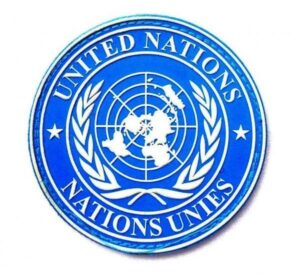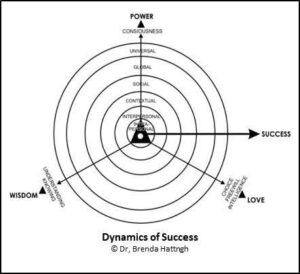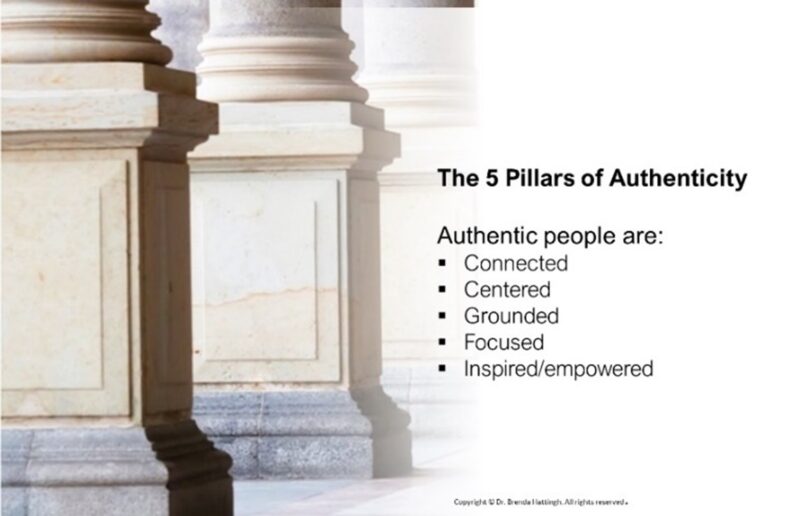Enlightened Leadership
Power Intelligence in Action
The Appleton Greene Corporate Training Program (CTP) for Enlightened Leadership is provided by Dr. Hattingh Certified Learning Provider (CLP). Program Specifications: Monthly cost USD$2,500.00; Monthly Workshops 6 hours; Monthly Support 4 hours; Program Duration 24 months; Program orders subject to ongoing availability.

Personal Profile
Dr. Hattingh is a leading executive coach and a qualified psychologist and lectured to MBA students in organizational psychology at leading universities. She is also an international speaker, authentic, enlightened leadership expert, and author of over twenty-five books.
In the early 1990s, Dr. Hattingh was appointed, under the leadership of Nelson Mandela, as part of the healing, change, and transformation agents of a country like South Africa in crisis. She received the Professional Business Woman of the Year Award for her transformational contributions.
The inspiring transformation journey of Nelson Mandela is a living example of what enlightened leadership and Power Intelligence in action are all about. He emerged as one of the world’s most acclaimed leaders, mentors, bridgebuilders, pathfinders, and mapmakers, forging a new path to a quality future that benefitted all. Madiba, as he is lovingly known, was a modern-day alchemist who could turn lower-order mindsets, power games, anger, frustration, hate, and the inevitable implosion of a country and its people into peace, harmony, cooperation, resilience, and progress. His light still shines brightly.
Dr. Hattingh has published two books on the life and leadership of Nelson Mandela.
This is the essence of Enlightened Leadership. This is also the essence of the new emerging intelligence, Power Intelligence – the intelligence of the future. Welcome to this program on enlightened Leadership, where you will learn about Power Intelligence in action from an experienced thought leader, pathfinder, and mapmaker.
Dr. Hattingh has over 30 years of experience in executive coaching, business and HR consulting, and training CEOs, Executives, and leaders in various positions in self-coaching, Power Intelligence, Enlightened leadership, and strategic planning. She has also facilitated change and transformation in communities, teams, companies, organizations, and government departments. Her clients include Anglo-American, the Reunert Group, Zeis International, Sasol, The South African Government, the SA Defence Force, the SA Police services, Mercedes-Benz, Audi, Volkswagen, Nissan, SANLAM, Independent Development Corporation (IDC), Telkom, and other national and international companies.
Dr, Hattingh’s areas of Expertise cover personal development by recovering our DNA success blueprint, transforming companies by rewriting organizational DNA, and developing enlightened leaders. She uses the science of Epigenetics in the workplace to enhance organizational culture. Her work is about recovering our original DNA blueprint as our authentic selves, rewriting personal and organizational DNA, and enhancing organizational culture while creating a new mindset and foundation to secure a sustainable future.
Her wide range of industry experience includes various sectors, like Human Resource Development, Technology, Education, Banking and Financial Services, Insurance, Oil and Gas, Healthcare, Mining, Communications, Agriculture, Automotive Industry, and Energy. She has commercial experience in the following countries and cities: New York in the United States, London in the United Kingdom, Johannesburg and Cape Town in South Africa, Stuttgart in Germany, and Sydney in Australia. Other African cities and countries include Windhoek in Namibia and Cairo in Egypt.
Dr. Hattingh has excelled in providing the latest research and development of new, cutting-edge information on Power Intelligence, Epigenetics in the workplace, and Enlightened Leadership. Self-coaching, personal and organizational assessment, and new development strategies form part of her body of work that includes over twenty-five published books. She is also an international speaker and is frequently invited as a keynote speaker at national and international academic conferences and business and organizational events.
Her aim is not only to bring Enlightened Leadership with Power Intelligence and all it encompasses to the marketplace at a time like this – but to contribute to making authentic, enlightened living and leading a way of life. You are invited to join this exciting adventure of discovering this new power and potential for – herein lies our future. You are invited to join this exciting adventure.
To request further information about Dr. Hattingh through Appleton Greene, please Click Here.
(CLP) Programs
Appleton Greene corporate training programs are all process-driven. They are used as vehicles to implement tangible business processes within clients’ organizations, together with training, support and facilitation during the use of these processes. Corporate training programs are therefore implemented over a sustainable period of time, that is to say, between 1 year (incorporating 12 monthly workshops), and 4 years (incorporating 48 monthly workshops). Your program information guide will specify how long each program takes to complete. Each monthly workshop takes 6 hours to implement and can be undertaken either on the client’s premises, an Appleton Greene serviced office, or online via the internet. This enables clients to implement each part of their business process, before moving onto the next stage of the program and enables employees to plan their study time around their current work commitments. The result is far greater program benefit, over a more sustainable period of time and a significantly improved return on investment.
Appleton Greene uses standard and bespoke corporate training programs as vessels to transfer business process improvement knowledge into the heart of our clients’ organizations. Each individual program focuses upon the implementation of a specific business process, which enables clients to easily quantify their return on investment. There are hundreds of established Appleton Greene corporate training products now available to clients within customer services, e-business, finance, globalization, human resources, information technology, legal, management, marketing and production. It does not matter whether a client’s employees are located within one office, or an unlimited number of international offices, we can still bring them together to learn and implement specific business processes collectively. Our approach to global localization enables us to provide clients with a truly international service with that all important personal touch. Appleton Greene corporate training programs can be provided virtually or locally and they are all unique in that they individually focus upon a specific business function. All (CLP) programs are implemented over a sustainable period of time, usually between 1-4 years, incorporating 12-48 monthly workshops and professional support is consistently provided during this time by qualified learning providers and where appropriate, by Accredited Consultants.
Executive summary
Enlightened Leadership
History
Humanity is experiencing a major shift in consciousness and awareness, which is a power shift. This is currently occurring at fundamental genetic levels as new DNA potential emerges. A new kind and quality of human being is emerging who will create a new future of health, wealth, happiness, success, and prosperity that benefits all. At the same time, a new kind of leader is emerging as an authentic, enlightened leader. Leadership is, first and foremost, not a position; it is a way of life.
These shifts occur automatically in nature, ensuring that only the fittest survive. As human beings, we can choose to undergo change and transformational processes and move to the next level—or not. The challenge is to help people make the right choices and move to the next level. In the process, they learn how to recover their original DNA success blueprint.
To successfully navigate the power shift, we need a new mindset, heart-set, and skillset, as well as a whole new intelligence—Power Intelligence (PI). Power Intelligence is the intelligence of the future.
The aim of Power Intelligence is to recover our authentic DNA success blueprint, release untapped genetic potential, and move to the next level while securing a quality future. The quality of the future depends on how we navigate this process – now. We hold the future in our hands.
This program is the result of over twenty years of research and development. The Human Genome Project revealed that DNA, as a blueprint of who we are, is not static and can change and transform. With the right tools and skills, we can consciously and mindfully tap into our genetic potential and recover and restore our original DNA blueprint, which holds the keys to a fully functional, successful, happy adult fulfilling their roles in all life contexts, including their careers.
Being disconnected: Unfortunately, over 80% of people are unknowingly disconnected from all this power and potential. A shadow ego-self was created in a world of struggle, conflict, corruption, and survival. This is transferred to companies and organizations, obstructing progress. It takes the special kind and quality of a leader to overcome these obstacles and take their people to the next level. Such a leader was Nelson Mandela.
The purpose of Power Intelligence is to consciously recover our original DNA success blueprint, live our best life to its fullest potential, and synergize with others while creating success and prosperity. This secures a quality future because we are creating the future now! By implementing the Power Intelligence process in our organizations, we also rewrite organizational DNA.
Recovering organizational DNA: Rewriting organizational DNA is more than restructuring an organization. Human potential must be developed harmoniously with the organization’s growth to maintain balance and secure a seamless transition. This aspect is currently lacking. Implementing the Power Intelligence process harmonizes organizational change, transformation, and development with leadership and HR development.
PI is based on activating the frontal lobe of the brain – our Power Spot. Here, we can tap into new vision, creativity, inspiration, and guidance. When we are connected to the Power Spot, it functions as our inner GPS that navigates our choices, direction and progress.

Being stuck: Unfortunately, most people are disconnected and ego-driven and, therefore, lost or at least stuck. The challenge is to help people, especially in leadership to become unstuck, get reconnected, find direction, become self-aware, and reclaim their authentic selves. In the process, they recover their original DNA success blueprint and help others to do the same. This is the aim of this program.
Each person, community, company, organization, and humanity as a whole is on the brink of something big. However, we first need to start with ourselves.
Current position
Power Intelligence: As a new paradigm, Power Intelligence emerged onto the scene over twenty-five years ago. Since then, PI has moved from outside general awareness and is now taking center stage. As a paradigm moves to the core, it attracts leaders at various stages. The definition of a leader is ‘someone who shows the way.’. Leadership is not about a position. Being a leader is a way of life. Many CEOs, leaders, and individuals have joined the Power Intelligence process over time as ‘first responders’ and visionary leaders. They also participated in the further development of PI and have taken their companies and organizations on this journey. This includes companies like SASOL, Anglo-American, Zeiss International, and academic institutes like the University of Johannesburg and UNISA School for Business Leadership (SBL), the South African Government, Reunert Group, and others.
You are here now: The fact that you are now reading this makes you an excellent responder. Why? Because the time is right, you have heard the call, and are here NOW. By following and implementing the Power Intelligence process, you become an authentic, enlightened leader who can lead from the heart and soul.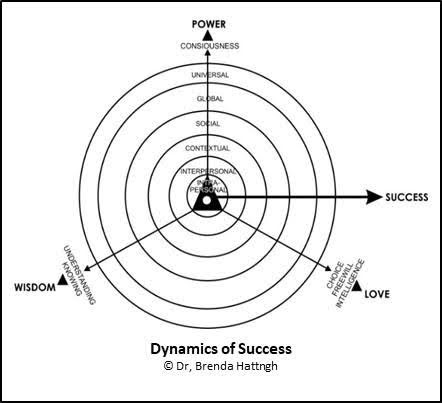
The three fundamental principles on which true success is founded are POWER, WISDOM, and COMPASSION/LOVE.
Balance: Unfortunately, most people don’t know how to balance these three forces and, therefore, struggle, push, pull, and stress to achieve success. The aim of the Power Intelligence process is to bring relief of these debilitating factors by instilling effortless ease and flow. This method has a major impact on personal health, wellness, and resilience. Research has shown that over 80% of people live stressful lives and are subject to burnout. This leads to health and wellness issues, escalation of absenteeism, staff turnover, and negatively influencing consistency and productivity.
The current shift from ego-driven to authentic, soul-inspired living and leading is a shift in consciousness and values, as seen in the diagram below.
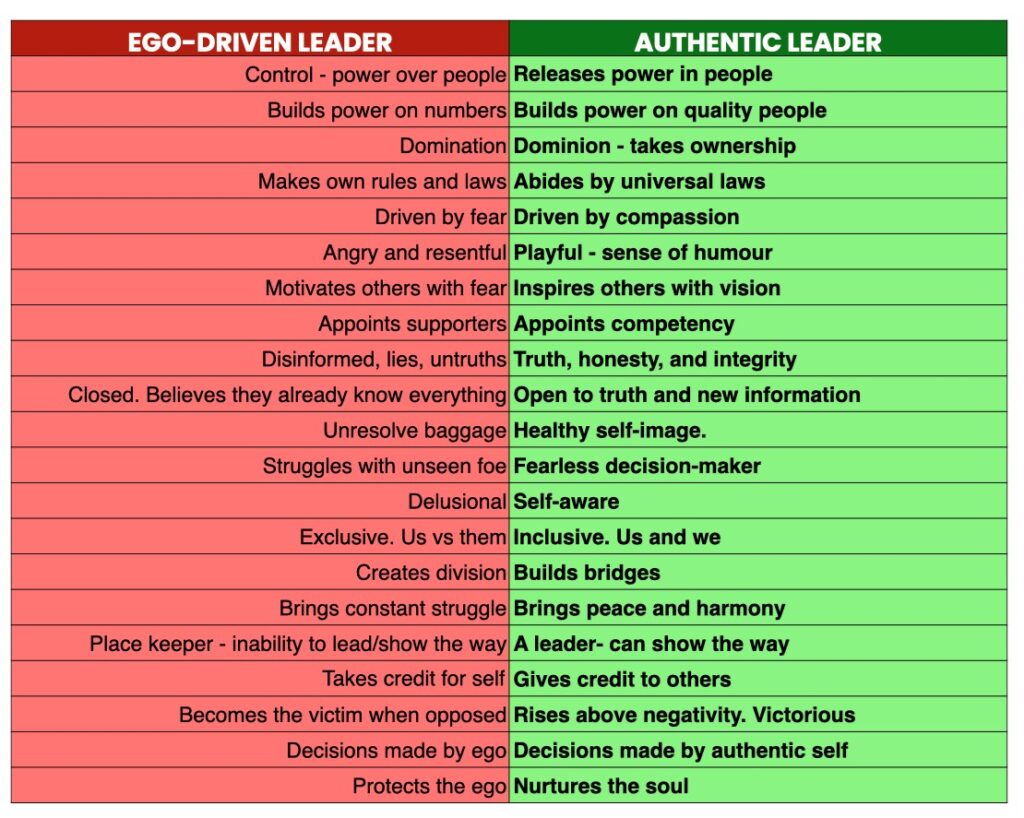
Real success: The shadow ego-self defines ‘success’ as acquiring power, positions, and possessions and making money. The authentic self sees ‘success’ as becoming fully functional and leading an authentic, happy, and fulfilling life.
Over 75% of people are still stuck in the ego mode, which negatively impacts organizational development. The challenge is to grow awareness, for we only need 20% of new thinkers, leaders, and their followers as a critical mass to tip the scales and secure success and progress.
The PISP: To make the Power Intelligence Leadership and Corporate Development program more tangible and cost-effective, we developed the Power Intelligence Success Profile (PISP). Not only does the PISP give you a clear indication of where you currently stand in the success process as an individual, but it also provides a PISP Wellness Report (PIWR), a PISP Resilience Report (PIRR), and a Self-coaching (PISC) and development program.
At the same time, the PISP provides a PI team and PI organizational report indicating where the company currently stands as an answer to the question, ‘Do they have the energy to succeed?’ The PISP Report includes clarity on the levels of wellness and resilience and a specific development program for the team or organization. This not only brings understanding and clarity but also focus, accountability, and inspiration to navigate the path forward. Twenty-two leading companies and over 7000 people, spanning different cultures, creeds, age groups, and positions, participated in the development and standardization of the PISP, which has an effectivity and reliability coefficient of 91%.
The PISP has benefitted thousands of people and various companies to make the quantum leap to the next level.
Year 1
In Year 1, each participant receives a personal workbook, access to complete their Power Intelligence Success Profile (PISP), and the E-book, ‘Power Intelligence 1.0. Developing the Enlightened Intelligence of the Future.’ The following outlines represent the key program objectives (KPO) for each course workshop.
Year 2
Although the Leadership Development Profession is a multibillion-dollar profession, it has failed to produce the quality leaders to take us forward and upward. This is because, up until now, these processes were primarily ego-driven. ‘Leader’ comes from Latin leido, meaning ‘to show the way’. The questions are: What way? From where to where do we lead? What does leadership look like to the shadow ego-self? What is leadership like for the authentic enlightened self? What does the future look like, and how do we get there?
Currently, radical change is taking place right down to the DNA level. New genetic potential is emerging, elevating human consciousness to a new level. This represents a leap to authenticity and a new season of health, wealth, happiness, success, and prosperity. At the same time, new, enlightened leaders are emerging as our new pathfinders, mapmakers, and bridgebuilders. They are the alchemists of the future.
A new human gene pool is emerging, which holds the codes and keys to a future of health, wealth, happiness, success, and prosperity that benefits all. These processes include recovering the original DNA leadership blueprint, thereby enabling enlightened leaders to take in their place.
With a new mindset, heart-set, and skillset, we can consciously recover this original authentic DNA blueprint and show the way to a new and brighter future. In this series of workshops, we learn how to recover our original DNA Leadership blueprint while helping others to do the same. The future is being created now. Each workshop represents a step on this path of developing authentic, enlightened leaders to show the way forward.
Year 2 is based on the book ‘New Leadership DNA’, developing Enlightened Leaders.
Included is:
• The E-book. Authentic Leadership. Recovering your DNA leadership Blueprint.
• Access to do your Power Intelligence Success Profile 9PISP)
Future Outlook
New foundation: The Power Intelligence Enlightened Leadership and Corporate Training Program not only lays a new foundation while forging a new path to success but also enables the highest potential in each individual while elevating the company’s effectiveness, productivity, and progress.
This program uses current research and universal wisdom to foster personal transformation, including effective team development and continuous improvement. The participants are empowered to transfer this new mindset and skillset to their work situation to enable top performance in a highly demanding environment, usually with a very young and constantly rotating workforce.
Core structure: This program is built on the core principles taught by The Centre of Power Intelligence since 2003. This core has led to the rapid expansion of Power Intelligence, which includes the Power Intelligence Academy, which provides books, assessment, and training material while facilitating teaching, coaching, mentoring, and leadership development. The company has grown exponentially over the last ten years, including the Power Intelligence Academy, which provides new trainers, coaches, facilitators, mentors, and leaders in Power Intelligence.
United Nations. This program also aligns with the United Nations Development Goals and Vision for 2030 released in 2015, titled Transforming our World: The 2030 Agenda for Sustainable Development. The agenda is based on five development goals: People, Planet, Prosperity, Peace, and Partnership.
Shaping the future: Program participants gain both clear insights and practical implementation strategies for shaping the future NOW. They develop a new mindset, heart-set, skills, and tools that foster leadership and accountability and empower them to deal with a complex, uncertain, ambiguous, rapidly changing world.
They develop a deep understanding of the Power Intelligence model, including the personal and organizational accountability necessary for successful implementation.
Einstein said, “You cannot bring about change by force – only by understanding.”
This understanding will lead participants to build the psychological safety and stability necessary for wellness and resilience, as well as to implement success strategies while influencing and emphasizing new behavioral standards in their organizational design.
Corruption: At the same time, the PISP report indicates underlying forces that influence organizational culture. Although much has been written about corruption, this debilitating force is still active in many organizations and rampant in many countries. Corruption is, first and foremost, a mental health issue and needs to be treated as such. In this course, we address ethics and identify solutions to corruption.
Artificial Intelligence: Power Intelligence has become the number one skill to develop in a rapidly changing world where Artificial Intelligence (AI) is taking center stage. Balancing and harmonizing technological development, the machine (AI), with developing new human potential through Power Intelligence (PI) is imperative in maintaining balance and synergy between man and machine.
Epigenetics: With Epigenetics in the workplace, it only takes a few forward thinkers and a group of influencers to enable new potential on a DNA level. Epigenetics is the understanding of how the environment influences the expression of our DNA potential. On the other hand, activating new DNA potential influences and changes the environment, teams, company, and organization. Implementing Epigenetics, with these understandings and universal wisdom, fast-forwards progress and instills job satisfaction, happiness, and flow.
Quantum leap: The challenge is to empower people to make the power shift as a quantum leap to secure a quality future. We aim to develop enlightened leaders as our new pathfinders, mapmakers, bridgebuilders, and modern-day alchemists who can navigate the power shift and transform lower-order potential into higher-order knowing, understanding, and progress. We include life and leadership lessons from the enlightened leader Nelson Mandela.
Nelson Mandela paved the way and set an example of enlightened leadership. He called this path ‘The Long Walk to Freedom.’ This program includes two e-books on the life and leadership of this iconic leader.
This program is meant for those who want to become authentic, enlightened leaders and influencers for the greater good. They are willing to start with themselves, where they are, who they are, and with what they have.
These are people like you who are invested in becoming part of the solution the world now needs.
You will find feedback from happy clients about the Enlightened Leadership Corporate Training program in the references.

Case Study: CEO Stan
Stan, a 32-year-old CEO of a large IT company, was brought in to turn the business around during a time of restructuring and a pending international merger. Amidst financial instability and employee retrenchments, Stan also faced personal pressures: a new baby, a vulnerable wife, and a recently changed home environment.
Despite these challenges, Stan’s Power Intelligence Success Profile (PISP) indicated a 7.8% PI Positive force. While relying on strengths like leadership, big-picture thinking, and self-discipline, he was also drained by fears, frustrations, and unclear priorities. The data warned of potential burnout due to overextension and neglect of personal wellbeing.
Stan’s strengths included responsibility for others, self-respect, and inner character. However, his personal and intimate life were neglected. He was getting little rest, not eating well, and avoiding exercise. This imbalance posed serious risks to his health, marriage, and organizational goals.
To counteract this, Stan took strategic action: improving his diet, playing squash, taking his wife on a weekend getaway, and communicating openly with his staff. He committed to coaching sessions and made personal development a priority. Honest communication became a key focus. He began to see frustrations as indicators for growth and acknowledged fears of criticism, powerlessness, and failure.
Stan expanded his leadership by understanding the importance of emotional intelligence and managing “soft” issues, once overlooked. Through coaching, he gained tools to manage fear, frustration, and realign priorities toward balance.
His quadrant profile showed limited perception, initially sufficient for financial goals but inadequate for innovation. Guidelines were set to expand his perspective in priorities, fears, strengths, and frustrations.
Stan’s plan of action included:
• Personal time management
• Family connection and quality time
• Diet and exercise routines
• Coaching and leadership development
• Staff empowerment through open communication
Outcome: Stan successfully navigated personal and organizational demands, establishing himself as a balanced leader while guiding his company toward innovative growth.
Curriculum
Enlightened Leadership – Part 1- Year 1
- Part 1 Month 1 New foundation
- Part 1 Month 2 Neurodiversity
- Part 1 Month 3 Emotional Intelligence
- Part 1 Month 4 Motivation
- Part 1 Month 5 Processing information
- Part 1 Month 6 Health and Wellbeing
- Part 1 Month 7 Gender orientation
- Part 1 Month 8 Social Intelligence
- Part 1 Month 9 Religion, and spirituality
- Part 1 Month 10 Self-Awareness
- Part 1 Month 11 Contextual Intelligence
- Part 1 Month 12 Making Money
Enlightened Leadership – Part 2- Year 2
- Part 2 Month 1 Who and what is a leader?
- Part 2 Month 2 Leadership and Navigation
- Part 2 Month 3 Enlightened Leadership
- Part 2 Month 4 Mind-wellness
- Part 2 Month 5 Alchemy
- Part 2 Month 6 Power Shift
- Part 2 Month 7 Science of Success
- Part 2 Month 8 Resilience
- Part 2 Month 9 Support systems
- Part 2 Month 10 Transformational Change
- Part 2 Month 11 Developing Enlightened Leaders
- Part 2 Month 12 Self-coaching leaders
Program Objectives
The following list represents the Key Program Objectives (KPO) for the Appleton Greene Enlightened Leadership corporate training program.
Enlightened Leadership – Part 1- Year 1
- Part 1 Month 1 New foundation – As the world and its people change and shift, we need to lay a new foundation. The foundation is found by understanding three important concepts: what is the truth about success, happiness, and prosperity, what does the future hold, and how do we co-create this new future? In this workshop, we start by developing a big-picture view of life. The next step is to draw up a map of obtaining this prosperous future. The third step is identifying all the necessary skills and tools, including developing Power Intelligence, to create this prosperous future. We find the answer to the question, What is an enlightened leader? After this workshop, you will have a new mindset with a list of ten vital skills and tools that must be developed to reach the next level of success and prosperity. You will also know how to navigate the power shift and take others with you.
- Part 1 Month 2 Neurodiversity – Research shows that we need a basic skillset containing ten parts of human functioning to succeed and move forward as healthy, healed, fully functional, mature adults. The first skill on this list is mindpower, how the brain functions, and rational intelligence or IQ. Neurodiversity has become an essential factor in understanding people and the diversity they represent. In this workshop, we focus on the different parts of the brain, how people think, and what people think. We focus on emerging a ‘new brain’ as the fourth brain situation in the Frontal Lobes. This is the seat of Power Intelligence. Here, we can consciously heal our DNA and restore our original DNA success blueprint. Essential skills include activating the frontal lobes, problem-solving, creative thinking, and realistic vs. unrealistic thinking. You will leave with a new mindset after this workshop.
- Part 1 Month 3 Emotional Intelligence – Emotional intelligence (EI) became an essential skill to develop after the book by Daniel Goleman. In this workshop, we focus on Emotional Intelligence and how to reclaim your power from negative emotional programming while creating a new, uplifting emotional climate. We lay a new emotional foundation and set a steadfast emotional baseline. We focus on defining negative emotional programming that is debilitating and healing the emotional wounds that caused this. Important emotional skills include forgiveness, healing, gratitude, love, and compassion. And the alchemy of the heart. You will leave with a new heart-set after this workshop and will be able to create a new emotional climate just where you are with what you have.
- Part 1 Month 4 Motivation – Motivation comes from the word movere which means ‘to move’. Where e-motions provide the energy to move, motives provide the reason to move. In this workshop, we focus on driving forces and answer the question, what makes people do what they do? We identify negative driving forces like fears and frustration and positive ones like vision, priorities, and strengths. We focus on self-motivation, inspiration, and how to set clear intentions. After this workshop, you will leave with a new set of driving forces, motives, and a GPS that will take you forward. Unfortunately, ego-driven say one thing but do something else. This is the bases of corruption. Setting clear and concise intentions is an important skill to secure personal and organizational ethics and prevent corruption.
- Part 1 Month 5 Processing information – Although we know how important communication is, very few people know how to communicate effectively. This not only leads to misunderstanding but also to conflict. We focus on more than just communication – we focus on information processing. Communication has three steps: perceptions, processing, and communication. Because of the diversity of people, perceptions, processing, and communication styles differ. By identifying the different processing styles, we not only develop better communication skills but will be able to create better relationships. After this workshop, you will leave with a map to process information effectively, how to manage meetings, and how to communicate your message effectively.
- Part 1 Month 6 Health and Wellbeing – Our physical health and well-being are important parts of functioning. The health and wellness industry has boomed over the last two to three decades. However, each person functions uniquely. Here, we learn to understand our unique physical functioning, including the effect aging has on our bodies. We explore the effect of mental health on our physical health and well-being and devise a personal plan of action to support our physical fitness and health. After this workshop, you will leave with a map of your physical health and mental and emotional wellness.
- Part 1 Month 7 Gender orientation – As human beings, we are also gender-related beings. Our gender is encoded as a DNA code as a Y-chromosome as male or female. However, the expression of gender identification comes in different forms. Because of the growing understanding of human gender diversity, the GBTL community is more readily recognized today. This workshop focuses on gender, gender identity, and healthy sexuality. You will leave with a new understanding of gender-related issues and new skills to manage gender. This includes the healthy expression of gender identity and sexuality in the workplace.
- Part 1 Month 8 Social Intelligence – Human beings are social beings. However, it is sometimes difficult to fit in in a diverse world. For this, we need special social skills. The authentic self and the shadow ego-self have different social skills because they have different value systems. The authentic self is open and accessible, while the shadow ego-self is closed and reverts to power games, intimidation, manipulation, and control. This workshop focuses on developing four important social skills that will help you to be comfortable in any situation.
- Part 1 Month 9 Religion, and spirituality – Human beings are also spiritual beings. Our higher, spiritual, or transpersonal component stretches far beyond our physical reality. Religions worldwide have tried to capture this essence in their teachings, dogma, and religious practices. However, not all religious people are spiritual, and not all spiritual people are religious. This workshop focuses on the common denominators of connections, love, and compassion throughout all our major religions. We focus on how to connect and allow the power of the Universe to flow to us, in us, and through us to others. These are important spiritual tools, irrespective of your religion. You will learn to respect different belief systems and harness the power of diversity.
- Part 1 Month 10 Self-Awareness – Much has been said about the importance of a positive self-image. In this workshop, we focus on the healthy expression of self, such as self-awareness, self-discipline, self-acceptance, self-love, self-mastery, and an integrated, whole, fully functional, authentic self. On the other hand, we all have a shadow ego-self, which is self-centered, self-serving, lacks self-awareness, is driven by fear and anxiety, and opts for unhealthy self-expression in depression, addiction, compulsion, and obsessions. Self-mastery tools include healing and overcoming the shadow ego-self, finding your true soul purpose, and expressing the self in a healthy, creative way that brings joy and happiness to all. You will leave this workshop with a new mindset about who you are as an authentic person and the difference between living life as an ego trip or with the power and potential of a soul journey.
- Part 1 Month 11 Contextual Intelligence – Most of us fulfill multiple roles within different contexts, all at the same time. You are a partner, mother, father, friend, brother, sister, boss, colleague, team-mate or work associate. All these roles can be depicted as different sports being played on other fields with distinct boundaries, players, rules, skills, and tools. At the same time, you need to pivot from one context or playing field to another in an instant. This requires emotional and personal maturity, flexibility, and resilience. In this workshop, we focus on six important skills necessary to play the games of life and win every time. You will learn how to show up on every playing field and be flexible enough to move from one situation to another with effortless ease. Not only does this reduce stress, but it is fun. You also learn how to feel free to experience fun and pleasure. In this workshop, you will learn about contextual intelligence, how to play the games of life – and win every time.
- Part 1 Month 12 Making Money – The science and psychology of Making Money. Making money and cash flow is at the heart of every business and also of peoples’ personal lives. The flow of money and healthy cash flow are like blood flow through your body. As long as the blood flows freely, you are healthy. However, when there are obstacles and blockages, you become sick. Financial wellness is an important part of the survival of a company and organization. In this workshop, we learn about the science and psychology behind ‘making money and how to make ends meet. This is much more than financial management. It includes a new mindset and attitude towards money, with new self-coaching skills to manage the fear and control money has over ego-driven people. Financial freedom and well-being are just as important as personal and organizational well-being. Important skills include changing the meaning and value attached to money and how to make more money and make ends meet. Conclusion: The Power Intelligence Success Profile 9PISP). In this workshop, we validate the change and transformation that took place over this year by repeating the Power Intelligence Success Profile (PISP). Here, we find all the changes that have taken place and what needs to be done. We will work through the PISP Report and complete the PISP worksheet. Here, you will find what steps you need to take next. We close off with a celebration of the progress made before embarking on the next chapter of the PI Leadership and Corporate Training program.
Enlightened Leadership – Part 2- Year 2
- Part 2 Month 1 Who and what is a leader? – To understand the true meaning of authentic, enlightened leadership, we need to revisit the history of leadership and leadership Development, which includes leadership, power, and authority. We find answers to the questions: Who is a leader? What is a leader? How do we lead? How do traditional leadership perspectives different from authentic enlightened leadership? What is the difference between a shadow ego-driven leader and an authentic leader? This workshop focuses on laying a new foundation for leaders and leadership by creating a new mindset, heart-set, and skill set that will take us forward. The aim is to recover the original DNA Leadership Blueprint of authentic, enlightened leaders that will take us forward.
- Part 2 Month 2 Leadership and Navigation – To lead means always moving from one point to another. The questions are: Moving from what to what and why? How do you create buy-in and movement? Where do the leaders get their guidance to move? This workshop focuses on communication, guidance, foundations, value systems, perspectives, and beliefs that influence decision-making processes and guidance.
- Part 2 Month 3 Enlightened Leadership – Authenticity is a choice to live your original, best, authentic, or higher self in everything you do, including leading. Leaders need to be able to distinguish between ego-centered leadership and soul-driven leadership. This applies not only to their own leadership but also to the style of their fellow leaders with whom they must negotiate. This workshop clarifies the different foundations of ego-driven leaders and authentic leaders. We lay a new foundation with the Five Principles of Authentic Leadership. Essential leadership skills include developing self-mastery and integrity and coping with the negativity of corruption and corrupt leaders.
- Part 2 Month 4 Mind-wellness – The new leader needs to have a fundamental understanding of neurodiversity and mind wellness. We focus on overall wellness, including mind wellness. Here, we find corruption to be a mental health issue that cannot be addressed by law. Corrupt needs to be healed. We cover the seven steps to healing corruption as the real pandemic of our time.
- Part 2 Month 5 Alchemy – As the new season of human consciousness evolves, a new intelligence emerges. This is Power Intelligence—the intelligence of the future. All enlightened leaders will have a new mindset, heart set, and powerful tools and skills to move forward. These are our alchemists of the future. In this workshop, we find answers to the questions: What is Power Intelligence? How does a leader become the new pathfinder, mapmaker, and alchemist of the future?
- Part 2 Month 6 Power Shift – The shift in consciousness is, in essence, a power shift. As the power shifts, so does the role of a leader shift. We identify four levels of power currently shifting from one to another. Only with a new understanding, including new skills and tools, will a leader be able to keep up. This workshop covers leaders’ power positions and how to keep up with the power shift.
- Part 2 Month 7 Science of Success – Success is a relative concept and can mean whatever your choose. However, a truly enlightened, authentic leader already has a vision of what success should be in the future. For the authentic self, success means becoming fully satisfied and leading a happy life of health, wealth, happiness, and prosperity. For the shadow egos-elf, with its self-serving values, success means acquiring more power, positions, and possessions, even at the expense of others. We focus on the science and psychology of success. This includes the science and psychology of making more money.
- Part 2 Month 8 Resilience – There is a difference between leadership and management. Leadership includes moving forward. Management means managing the here and the now and can include managing the budget, processes and even people. One of the major influences on leadership is negativity and the resistance to change. In this workshop, we identify blockages and learn how to overcome negativity and resistance. This includes resilience training.
- Part 2 Month 9 Support systems – Leaders are only as capable as their support systems. Building a strong support system is one of the vital ingredients for a leader’s success. The questions are: How do you choose the right people to support your vision? What are energy makers and energy breakers, and do these two groups influence progress?
- Part 2 Month 10 Transformational Change – A leader is the spearhead of change and transformation. The questions are: How do you change how people think, feel, believe, say, and do? What skills and tools are necessary to bring about change and transformation? How do you rewrite organizational DNA? What changes can we expect by 2035? This workshop focuses on answering these questions while creating a new mindset about how change and transformation are pivotal to our growth and survival and the vital role leaders play in the transformational process.
- Part 2 Month 11 Developing Enlightened Leaders – Training and developing authentic, enlightened leaders is pivotal to securing a new future. However, our education system, which includes training leaders, has only evolved to the level of tertiary education. The challenge is to move from primary, secondary, and tertiary to quaternary education and lay a new foundation of thinking and focus. This workshop focuses on the shift in education to quantum thinking, quaternary education, and a new approach to training leaders. In this process, we develop quantum thinking, quantum learning, healing, coaching, and mentoring.
- Part 2 Month 12 Self-coaching leaders – Self-coaching has become the number one skill in a constantly changing world. The questions are: What is self-coaching? Who coaches whom? Who is the authentic self? Who is the shadow ego-self? What skills and tools are necessary to coach ourselves to ultimate success? We explore the second Power Intelligence Success Profile Report while developing a plan of action for the next step. You will leave this workshop with a new mindset, earset, and new skills and tools to build your self-coaching ability and take in your place as a conscious, mindful, authentic, and enlightened leader.
We close off with a celebration of the progress made before embarking on the next chapter.
Methodology
Enlightened Leadership
Program planning
Foundation: The proven step-by-step foundation-building approach in this program allows participants to experience transformative results, propelling them to move forward confidently with a new mindset, heart-set, skills, and tools as empowered pathfinders, mapmakers, bridgebuilders, and leaders.
We start by laying a sound foundation of what true, authentic success embodies and pay attention to the science, psychology, and dynamics behind a successful person, team, company, or organization as outlined in the diagram. This is then transferred to the workplace. Participants, therefore, can successfully progress in their careers and bring more value to the workplace.
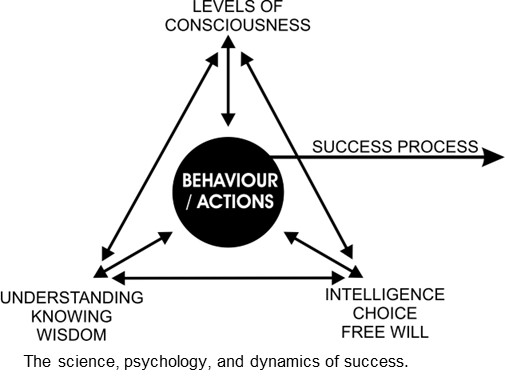
Research also shows that what individuals learn in the workplace influences at least five others in the participants’ personal lives. Therefore, families and communities also benefit from the time and money the organization invests in the training and development of their people.
Fundamental questions: The methodology is founded on fundamental questions every individual, especially leaders, needs to find answers to; What does the future hold? What will success look like in the future? What skills and tools do we need to create this successful, prosperous future? Who will stay behind, and who will move forward? What does DNA have to do with success? How do we recover our personal DNA blueprint? How do we rewrite organizational DNA and lay a new foundation that secures stability, resilience, job satisfaction, loyalty, wellness, sustainability, and longevity? What is my role and purpose in this process? What is Enlightened Leadership?
First step: The first step in laying this new foundation is to not only understand the science and psychology behind success, but to also be able too distinguish between the definitions of ‘success’ as revealed by the authentic self and the shadow ego-self.
The disconnected shadow ego self sees success as acquiring power, positions, and possessions, especially money. How they get there is secondary and can and does include corruption.
Authentic self: The authentic self knows that true success is all about becoming fully functional as a unique human being, bringing a unique contribution to the table. Money is the physical manifestation of providing unique quality products and services. This is what business is all about.
In this program, we focus on the dynamics of success and use the Power-Wisdom-Compassion (PWC) model to secure a sound foundation for sustainable success and progress, as seen in the diagram below.
Program development
The second step includes aligning the five pillars of authenticity and enlightenment. This is not as easy as it sounds because over 80% of people are still driven by the shadow ego-self, which is a hard taskmaster and will not easily let go of control in people’s lives. This means that there is much inner work and unlearning to be done to make way for the five pillars of success and authenticity. In the process, you learn to shine. These pillars are; Getting connected, centered, grounded, focused, and inspired about the future, as seen in the diagram below.
The third step is the answer to the question: What new mindset, heart-set, skills, and tools do we need to make the power shift and create this new future?
Research shows that we need nine important groups of skills and tools that not only need to be sharpened but constantly maintained and upgraded. These are: Rational Intelligence, that includes neurodiversity, thinking, and decision-making strategies; Emotional intelligence; Motivation and understanding driving forces and intentions; Processing information and effective communication, including active listening; Physical health and wellness; Gender identification and sexuality: Social skills and tools; Belief systems, religion, and spirituality; Self-awareness, self-coaching, and self-love.
The fourth step is to learn how to be flexible enough to manage and navigate the different context of life and also the different seasons of a project, company, or even life. It is important to maintain a balanced lifestyle that includes a happy, fully functional life at work, in a marriage or relationship, at home, with family and friends, and in social and religious environments. Without this balance, people revert to negativity, conflict, and struggle. Many become stuck and even become dysfunctional, which negatively affects everything and everyone else.
The question is, how do we become unstuck and move to the next level? This brings us to step five.
In step five, we use the Power Pyramid model to learn how to move to the next level while understanding where others function. The Power Pyramid provides a color-coded map of where you, your team, or your organization are currently functioning and what to do next in order to move forward. The Power Intelligence Success Profile (PISP) was developed from the Power Pyramid model as a personal and organizational self-assessment tool. The PISP provides a clear indication of the positive aspects and what still needs to be done. The PISP Report focuses on personal and organizational training and development, thereby making the investment of time and money cost-effective.
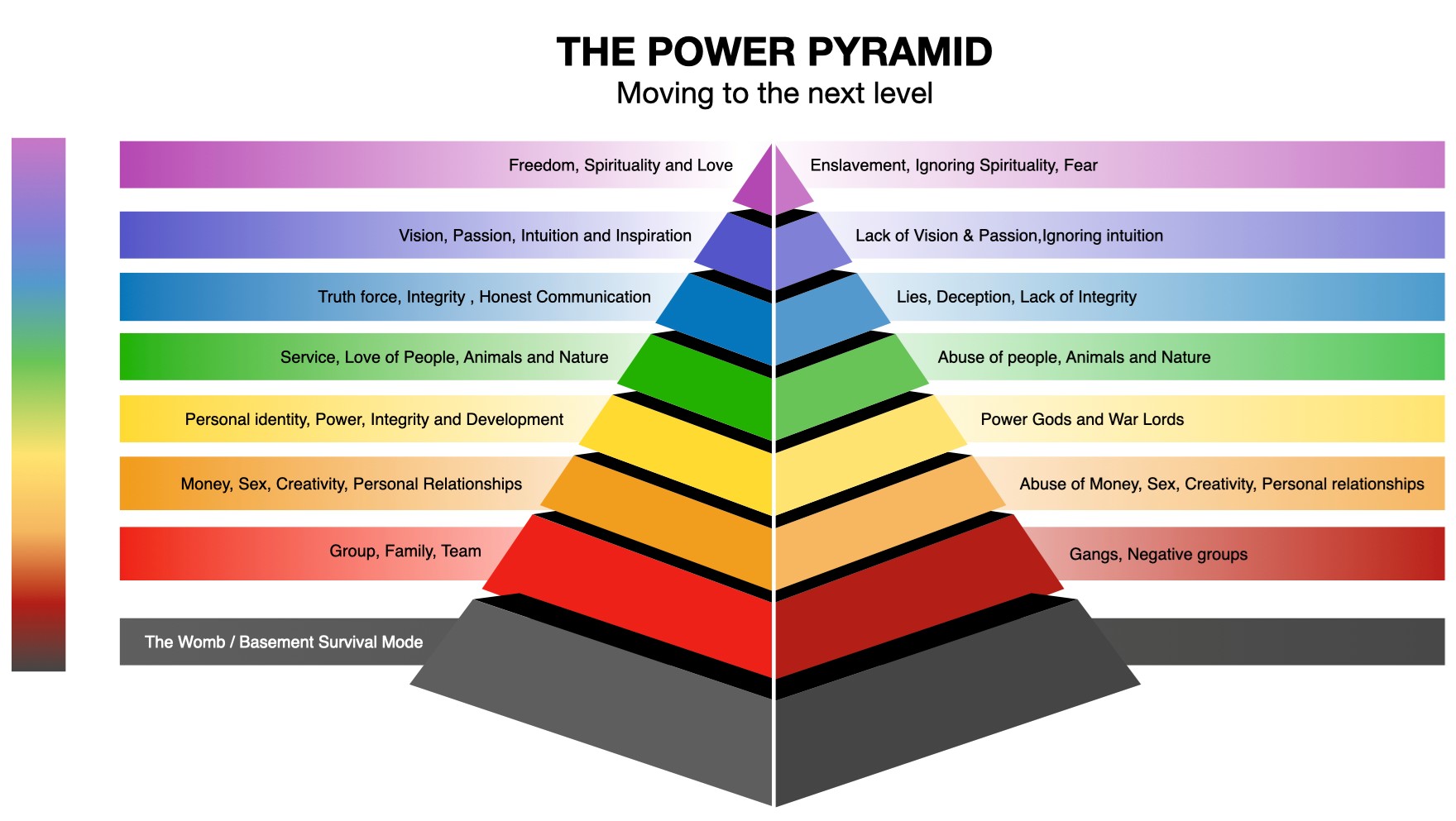
With time speeding up and rapid change, we need to refrain from a ‘shot in the dark training’ but secure a clearly focussed training program that meets the needs of the people and the time. A Power Intelligence Organizational Dashboard (PIOD) can be developed to meet the needs of each organization on request.
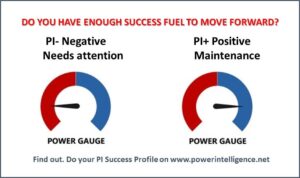
Program Implementation
The structure of the Enlightened Leadership and PI Organizational Development Program Part 1 runs over one year with twelve workshops of six hours, presented each month. Each workshop covers a specific topic relevant to the course as outlined in the curriculum. Each individual workshop consists of five parts:
Introduction: The introduction includes connecting to the participants and establishing common ground. Each section starts with a self-assessment of wants, needs, expectations, and contributions. Interactive participation and practical implementation of new mindsets and new skills in the workplace and personal life are supported and encouraged.
Objectives: The objectives for each workshop are clearly outlined to clarify understanding and expectations. This is usually done by formulating questions that each participant and the presenter need to answer.
How to achieve these objectives: The objectives are outlined, and the presenter and attendees include additional questions from the introduction. The questions are answered by presenting new information via presentations, video clips, discussions, or assessment tools where necessary. A list of practical actions, such as a To-do List, is compiled from open discussions and contributions from the presenter and participants.
Practical implementation: The Power Intelligence Success Profile (PISP) is implemented and discussed in the first session. A self-coaching program is developed and implemented throughout the coming weeks. In subsequent sessions, the To-do List is a guideline for practically implementing the new information, skills, and tools in the workplace and life in general. Each participant receives a workbook for personal notes, planning and progress indicators. Feedback from this process will be discussed in the Introduction of the next workshop, and adjustments will be made as necessary.
Assessment: Program review and assessment are done in every workshop and in various ways, including questionnaires, summaries, and the PISP, which is done every six months. An overall assessment is done at the end of the course to get an overall picture of the progress made before and after the PI course. This information opens the doors to continue with year 2, Enlightened leadership.
Follow-up and support: This is available through notes, E-books, and email follow-ups. Four support sessions are available in the weeks between each workshop.
Additional, each participant receives Daily Power Tools for Power People, delivered to their inbox.
Program Review
Constant program review, assessment, and realignment form part of the program’s development and implementation. Different methods are used.
Formal assessment: At the beginning of the program, the Power Intelligence Success Profile (PISP) is implemented. The PISP Report is used as a guide for personal self-assessment and the development and implementation of a self-coaching program.
The PISP also provides a collective company report represented by the group. The PISP Report is used to assess organizational resilience, wellness, and progress. The PISP is implemented every six months and provides quantitative guidelines for the program’s effectiveness. The program is flexible, and adjustments are made as necessary.
Self-assessment: The PISP provides quantitative and qualitative feedback to enhance self-assessment. Each workshop is also closed off with an informal program review that each participant must complete before the next workshop. Results are discussed in the introduction to the next workshop.
Review of information: The program is constantly reviewed against the latest information to keep up with the rapid change. Updates are included as the program progresses.
Participant feedback: Feedback is encouraged after every workshop. A midyear client assessment includes the implementation of the PISP and is a quantitative assessment of the progress. The participants will provide a qualitative assessment, which will be included in the workshops for the next six months.
Although some of the workshops cover serious topics, like corruption, they are open, interactive, and fun.
See what happy clients are saying in the references.
Industries
This service is primarily available to the following industry sectors:

Consultancy
History
For as long as humanity has been around, consulting has played a significant role in decision-making processes. The word ‘consultant’ comes from Latin, consultare which means “to deliberate”. A consultant is a professional, also known as an expert, advisor, specialist, thought leader, and new mapmaker, who provides advice or services in an area of specialization, usually in medium or large-size corporations.
A consultant provides “external advice for organizations that require specialist experience or an objective outside perspective on their business.” There are many different types of consulting, including management, strategy, economics, healthcare, human resources, and technology.
Consultants work with their clients and advise them on matters such as business development, finance, marketing, sales, operations, customer service, accounting, human resource development, and financial planning, among others.
A person becomes a consultant if they are experienced, proficient, and know how to make a difference in their areas of expertise. Each consultant has a niche market of expertise, including the necessary qualifications and training. Most of all, the best qualifications are experience and a proven track record that provides information on past successes.
The task of a consultant is to lend a different perspective than the business’s employees, providing guidance based on their experience handling similar situations. This expertise is valuable in ensuring the company implements suitable solutions, overcomes hurdles, or meets its objectives.
Seasoned, well-equipped, proficient, and transformative consultants don’t grow overnight. They grow over time. Choosing a consultant depends on the needs of the time.
Current position
There are two kinds of consultants. On the one hand, we have an individual with the right background and expertise who delivers their services when and where needed. On the other hand, we have consulting companies as the collective of various services. Every company is bound to have problems; consulting firms are contracted to identify and provide solutions, be proactive, and provide guidance and leadership for future demands, challenges, and preparation to meet future needs.
A consulting company is a business that provides expert advice, guidance, and solutions to clients who are having trouble with an issue over a wide range of areas. Consulting companies are made up of industry experts who can offer specialized knowledge and an outside perspective to help clients solve whatever they need. They also provide guidance and leadership on new trends, development, and future prospects. Leading consultancy companies will, therefore, secure only top thought leaders and the best industry experts to secure their service and stay relevant. And up to date. This secures not only the longevity of the consulting company but also the success, relevance and longevity of their clients and their businesses, companies, and organizations.
Currently, the top three c global consulting firms regarded as the Big Three (or MBB) are McKinsey & Company, Boston Consulting Group, and Bain & Company. Other large consulting companies include,
The global consulting industry is worth billions of dollars, with estimates ranging from $100 to $280 billion. The exact value depends on several factors, including the scope of markets, different definitions for consulting services, and regions and markets considered.
Two of the major consulting services are financial services and human resource development (HR).
Future Outlook
The consulting industry is expected to undergo significant change in the coming years. These changes are driven by a number of factors, including Technology. The rise of digital technologies and platforms will enable consulting firms to provide more flexible and accessible services.
Data and analytics. The increasing importance of data and analytics will require consulting firms to provide services related to digital transformation, data analytics, and cybersecurity.
Collaboration. The future of consulting lies in the collaboration between AI and human consultants. AI can assist with data analysis and automation, while human consultants bring critical thinking, creativity, and domain expertise.
Business models. Consulting firms will need to adapt their business models to meet changing client demands and enhance profitability. This includes adopting innovative business models such as contingency-based pricing and integrating digital advertising services.
Sustainability. Sustainability will be a key factor shaping the industry’s future.
Other trends that are expected to impact the consulting industry include: Clients will expect more authoritative and authentic points of view from their consultancies. Clients’ buying journey will be almost exclusively based on independent online research. Positioning will make or break a consulting business, and smart service design-based growth will be in.
The fact is that consultants cannot be replaced with Artificial Intelligence. Consultancy can only be augmented by AI. Rather, the future is about forging partnerships with subject-matter experts and specialist service providers through the creation of open consulting ecosystems. For a genuinely client-focused organization, the overriding imperative should be to provide the best possible expertise for each individual project.
Most of all, successful consultants have certain personality traits that include working with people, teaching, learning, facilitating, advising, guiding, and leading. They are deeply aware of their influence in the company and organization and take their consulting profession seriously. This means that the best consultants see their profession more as a calling to serve than a job that needs to be done.

Healthcare
History
The healthcare industry is one of the world’s fastest-growing industries. It spans various industries and sectors that provide services, goods, and products to secure a sound foundation of health and wellness. Generally, ‘health’ refers to physical health, and wellness refers to mental, emotional, and spiritual well-being. This covers all the four primary levels human beings function on: physical, mental, emotional, and spiritual/universal levels. This includes not only physical health and psychological wellness but also social health and wellness in the environments we live in.
Over the last few decades, the healthcare system has moved from focusing on sickness to focusing on health and wellness that spans various contexts. The United Nations’ International Standard Industrial Classification has established a basic framework categorizing health care by hospital activities, medical and dental practice activities, and “other human health activities.”
The last class involves activities of, or under the supervision of, nurses, midwives, physiotherapists, scientific or diagnostic laboratories, residential health facilities, pathology clinics, patient advocates, or other allied health professions. In addition, according to industry and market classifications, such as the Global Industry Classification Standard and the Industry Classification Benchmark, health care includes many categories of medical equipment, instruments, and services, including biotechnology, drug manufacturing, and delivery diagnostic laboratories and substances.
Current position
Different sectors address different areas of the health and wellness industry.
The medical profession: This demanding profession covers various contexts and services that include the training of medical doctors, nurses, hospital personnel, and medical staff. At the same time, teamwork forms the backbone of quality health services. Burnout is a general occurrence in the medical profession.
Nursing: The nursing profession is a demanding and exhausting profession, demanding high energy output and resilience. Burnout is a common phenomenon that needs constant attention.
Psychologists and Coaches: The scope of qualified psychologists has grown over the last two decades, and psychologists and counselors need constant training to stay up to date with the latest in mental health and emotional well-being development.
Healthcare insurance companies play a major role in the health and wellness of communities, governments, and countries. The topic of Health Care and Health Care Insurance is also part of political debates.
Organizational wellness: Organizational wellness has grown over the last two decades, from implementing physical health programs for their staff to implementing emotional, mental, and spiritual wellness programs to secure a sound foundation for a healthy culture that fosters growth and development. However, until now, there has not been a reliable assessment tool to assess organizational wellness.
Government wellness. The wellness level of a government sets the foundations for the wellness of a country. Investing in the wellness training of government officials secures a safe basis on which the government can deliver services to the country and its people. One of the major issues is corruption. Corruption is, first and foremost, a mental health issue and should be treated as such. Governments that invest in developing their countries invest in training to heal corruption.
Future Outlook
The World Health Organization (WHO) has several initiatives to address the future of healthcare. The World Health Assembly will consider the WHO’s draft Fourteenth General Programme of Work in 2024. This document will outline the WHO’s strategy and roadmap for the next five years. The WHO will continue to work to ensure sustainable financing to address the world’s complex health issues.
The WHO’s vision is for all people to attain the highest possible level of health. The WHO’s mission is to promote health, keep the world safe, and serve the vulnerable.
The future of healthcare professionals includes transforming and upgrading the training and preparation of healthcare professionals such as doctors, nurses, psychologists, home carers, emergency staff, and others in the healthcare profession. This includes self-care and self-coaching for professionals to cope with their different professions.
Wellness and well-being will become an important focus point. Healthcare 2030 “The Road to Wellness” is the blueprint for the transformation of the provincial health system. It outlines the importance of preventing illness through a healthy lifestyle, early detection, and healthy living. This will have a big impact on healthcare providers. Most of the care provided today is highly algorithmic and predictable. By 2040, high-cost, highly trained health professionals will be able to devote more time to patients who have complex health conditions. Data and technology will empower consumers to address many routine health issues at home.
The future of healthcare is predominately influenced by technology. Soon, doctors will interact with patients, not just through video calls but via robotic devices. Remote surgery, where doctors operate on patients miles away, is the future. Robotics will also transform home care, easing caregiver burdens. From now on, the quality and well-being of our healthcare professionals as persons will take center stage as the human factor drives the healthcare industry.
Wellness and well-being in companies and organizations will also take center stage to secure a healthy workforce and create a resilient, sustainable culture, thereby securing the organization’s longevity. In the future, leading companies and organizations will invest in a holistic approach to wellness training that includes physical, mental, emotional, spiritual, and social wellness and well-being.

Education
History
Education is part of human nature. Humanity can only progress according to the education we receive. The power of education was recognized by one of the world’s most iconic leaders, Nelson Mandela, who said, “Education is the most powerful weapon which we can use to change the world.”
He emphasized the importance of education as a fundamental necessity to bring equality of opportunity to the world. He believed, “The power of education extends beyond the development of skills; we need education for economic success. It can contribute to nation-building and reconciliation.”
Education in all its forms and on all levels is the backbone of the growth, development, progress, and success of all people, communities, companies, organizations, and developing countries. Education means growth. Without growth, you die. All developing countries, including industries, communities, companies, and organizations that invest in education and training, move forward and upward. Others stay behind.
Unfortunately, many organizations invest time and money in the training of technology and information technology as ‘hard’ skills training, but ‘soft’ skills training that includes communication, creativity, problem-solving, Emotional Intelligence, residence, and others are neglected. These so-called ‘soft skills’, however, form the basis of organizational culture and determine the work environment and wellness level of the organization.
The reasons given for this neglect are a lack of time and money. However, these ‘soft’ skills’ make an operation run smoothly. Today, we know that not only is the quality of technology important for progress, but the quality of employers and employees is just as important, if not more. The reason is that people are behind all the processes and need to work together. Quality education and continuous education and training in ‘hard’ and ‘soft’ skills are therefore imperative for the progress of each individual—community, business, government, country, and humanity as a whole.
Current position
Currently, education systems around the world are facing a number of significant challenges. This includes factors such as relevance, quality, access to education, inequality, and teacher training.
Where relevance is concerned, some say that education systems are built on a model from the Industrial Revolution that focuses too much on memorization and standardization and not enough on skills like creativity, independent thinking, emotional intelligence, and resilience.
Access and inequality are serious problems, and many schools in rural and impoverished areas lack basic infrastructure, such as clean water, electricity, and sanitation. Some countries are struggling to improve the quality of their education systems. Many countries have underqualified or unpaid teachers, and some countries are struggling with the cost of educational facilities, school supplies, and uniforms.
The consequence of these issues is that these students then enter the workforce. Their level, quality, and relevance of education then determine the organizational culture, progress, and success. Companies and organizations, therefore, have the innate responsibility to further educate their workforce. This includes more than technical and process training. Further training, education, and development of a workforce should include more ‘soft skill’ training to elevate the level of maturity of our workforce and secure a positive organizational culture.
Future Outlook
The future of education lies in moving to the next level. This means moving from primary to secondary, to tertiary, and now to quaternary education to secure a prosperous future. It includes moving past our current tertiary education systems while evolving to the quaternary level, which includes quantum thinking.
Quantum thinking includes activating the fourth brain, the frontal lobe of the brain – the Power Spot.
Unfortunately, traditional education systems, schools, colleges, and universities evolve slower than private education systems.
In the future, we can expect more private schools, colleges, and universities to evolve to keep up with the rapid change. A new kind of quality of teachers, lecturers, academics, trainers, and facilitators needs to emerge and develop to secure a new foundation in the education system. We can also expect a shift in HR development to embrace the rapid pace of change.
The future depends on sound education and training, which prepares people for the future.
The role of Artificial Intelligence (IA) will play a larger role in education in the future. This underlines the importance of introducing, implementing, and developing Power Intelligence (PI) at all levels of our education systems. This importance lies in maintaining the balance between humans and the machine. Any imbalance can and will pose a threat to future progress.
To meet the future challenges in Education is it is important for a new kind and quality of leader, enlightened leaders, to emerge and take their place. These enlightened leaders are the new pathfinders, mapmakers, and way-showers, preparing our youth and humanity as a whole for a prosperous future.

Automotive
History
Although steam-powered road vehicles were produced earlier, the origins of the automotive industry as we know it today, are rooted in the development of the gasoline in engine in the 1860s and 1870s in France and Germany. This is considered the beginning of the automotive industry. Karl Benz, a German mechanical engineer, built the first practical automobile in 1885 that was powered by an internal-combustion engine. The first public outing of the three-wheeled Benz Patent Motor Car was in July 1886.
In 1908, Henry Ford introduced the Model T, which made cars more affordable and accessible. In 1937 Volkswagen (VW) was established as a German automobile manufacturer, based in Wolfsburg, Germany, by the German Labour Front. Volkswagen was revitalized into the global brand it is today after World War II by British Army officer Ivan Hirst. To also make cars more accessible to the everyday person in the street, Alec Issigonis designed the Mini in 1959, which revolutionized small car design.
Over the decades, the motor industry became more sophisticated by introducing catalytic converters and emission controls in the 1970s and 1980s to address environmental concerns. In the 1990s airbags, anti-lock brakes, and traction control were added, becoming standard safety features in the 1990s.
In the early 2000’s Toyota Prius led the popularity of hybrid technology. Elon Musk founded Tesla Motors in 2003 with a focus on electric vehicles. Fruther advancements in autonomous driving are expected to play a significant role in shaping the future of transportation.
The automotive industry is currently a significant contributor to the economies of many countries and has long been used as a measure of countries economic performance. Not only does it support millions of jobs across various manufacturers, but it indirectly supports millions of people through its wide network of suppliers.
Current Position
Currently, the leading companies in the automotive industry include, Volkswagen Group, Toyota Motor, Daimler, Ford Motor, General Motors, Honda Motor, Hyundai Motor Company, Mercedes Benz AG, Tesla Motors, Nissan Motors, and others.
Leading automotive groups in terms of revenue ae currently, Volkswagen and Toyota. China was the leading car producer worldwide, with over 26.1 million units manufactured in 2023. This was over threefold the production of Japan, which came second in the ranking. While Japan was behind China in car output, the Japanese Toyota was the best-selling automotive brand worldwide in 2023.
In 2021, the US produced 9.16 million cars and commercial vehicles, making it the second-largest producer. Other leading countries in the automotive industry include Spain, South Korea and Canada.
Volkswagen is not only a traditional German brand, but a true global player and one of the world’s largest car companies. Other German automotive companies include Mercedes-Benz Group AG and Porche with headquarters in Stuttgart. BMW AG and Traton SE headquarters are in Munich while Audi is seen as a leading automotive company, with headquarters in Ingolstadt.
The United States (US) automotive industry is a major part of the global economy and the country’s economic engine. It’s the second largest automotive manufacturer in the world, after China, and the second largest market for vehicle sales and production. The industry is a major employer, with over 2.8 million people employed directly and indirectly
In the United Kingdom (UK) the automotive industry is a vital part of the UK economy, contributing £67 billion to the economy and employing over 780,000 people. With a wide global reach, the UK automotive industry ships vehicles, engines, and components to more than 150 countries.
Australia’s car industry grew rapidly after international manufacturers opened plants in the country. Holden produced the first Australian-designed mass-production car in 1948. In the 1970s, Australia produced almost half a million cars, making it the 10th largest car producer in the world.
South Africa’s automotive industry is a major contributor to the country’s economy, ranking third in the country’s economic sectors. South Africa is the 18th largest producer of motor vehicles in the world and produces more than half a million vehicles annually. The automotive industry employs around 112,000 people in manufacturing, and is responsible for around 320,000 jobs in total. The automotive industry is spread across three manufacturing hubs in South Africa. District like Gauteng is home to BMW, Nissan, Ford, Iveco, BAW, and MAN, as well as most major truck and bus manufacturers. KwaZulu-Natal: Home to Toyota, Mahindra, and Volvo while the Eastern Cape is home to VW, Isuzu, Mercedes Daimler, and Mitsubishi.
Leading car manufacturers in Africa include countries like, Egypt, Algeria, Ghana, Tunisia, and Uganda. South American car manufacturing countries include Brazil and Argentina, while in Europe, France, Spain, Belgium, Italy, and Eastern Europe countries are also car producers. The automotive industry is a strategic industry in many regions and countries, contributing to a significant portion of global GDP and it accounted for nearly 10% of world trade.
Future Outlook
The automotive industry is expected to see many changes in the future, including electrification, AI, new software, 3-D printing, autonomous vehicles, machine learning, and connected vehicles as part of the IoT, which creates opportunities for personalization, customization, and new business models. At the same time this poses challenges to sustainability.
These advancements create new challenges. For example, there is a security risk with autonomous vehicles. Other challenges include staying updated with digital trends, overcoming regional differences, and meeting supply-chain shortages. Artificial intelligence (AI) enabled assistants will have an impact on job creation. At the same time, prices are dropping, and there is a need to go beyond conventional business models.
The future of Germany’s automotive industry is expected to be impacted by a number of factors, including the transition to electric vehicles (EVs), the aging population, and shared mobility. The EV market in Germany is growing in both economic value and the number of vehicles. The market is projected to reach €103.4 billion by 2028.
Under the Biden Administration, the USA has secured that all small motor vehicles be electrified by 2035. This will have a major impact on the economy as the USA is a fossil fuel producing country. EVs could displace more than 20 million barrels of oil daily by 2040. The UK automotive industry is also on the path to a greener future, with the government setting ambitious targets to reduce emissions and increase the use of electric vehicles (EVs)
Futuristic cars are the dream of many. This includes more than sci-fi imaginations and Artificial Intelligence (AI) projection. The electric car is the first step in a new direction.
The future of the automotive industry in South Africa, like in many other African countries, is expected to be shaped by a number of factors, including technology, electric vehicles, shared mobility, robotics, AI and infrastructure. In Australia, like most other automotive producing countries will follow the trends now evident in the motor industry.
The transition to electric vehicles (EVs) will change the automotive industry from mechanical to electrochemical production. This will require new skills, such as digital and advanced manufacturing. Some jobs, like those that produce parts for internal combustion engine (ICE) vehicles, may be at risk of displacement. However, the transition may also increase the employment of women in the automotive workforce.
The changes in the automotive industry demands a vigilant Human Resource (HR) development.
HR professionals in the automotive industry will require professionals to handle employer-employee expectations better, which are in a state of flux. HRs will also need to become more people-focused, employee-centric, and human due to these new employee demands. Other changes in the HR industry include embracing innovation and experimenting with new technologies to drive continuous improvement.
One of the primary focusses is for HR to secure organizational wellness and the wellbeing of all. In the future HR professionals will focus on employee mental health and provide a healthy work-life balance. Building on their current strengths, the automotive industry leaders should focus on a few key areas of leadership development—both for themselves and for the future leaders they are developing in their companies.
Banking & Financial Services
History
Banking and financial services are at the root of all businesses, companies, organizations, communities and countries. The roots of modern banking are traceable to medieval and early Renaissance Europe, including Italy’s Lombards in the 12th and 13th centuries, France’s Cahorsins in the 13th century and in particular the rich Italian cities such as Florence, Venice, and Genoa.
Banking has been in existence since the first currencies were minted and wealthy people realized they needed a safe place to store their money. Ancient empires also needed a functioning financial system to facilitate trade, distribute wealth, and collect taxes. Banks were to play a major role in that, just as they do today.
Religious temples became the earliest banks because they were seen as safe places to store money. Before long, temples got into the business of lending money at interest, much as modern banks do. By the 18th century, many governments gave banks a free hand to operate, based on the theories of economist Adam Smith. Numerous financial crises and bank panics over the decades eventually led to increased regulation.
The barter system of exchanging goods for goods worked reasonably well for the earliest communities. It prove problematic as soon as people started traveling from town to town in search of new markets for their goods and new products to take home.
Over time, coins of various sizes and metals began to be minted to provide a store of value for trade.
Coins, however, need to be kept in a safe place, and ancient homes did not have steel safes. Wealthy people in Rome stored their coins and jewels in the basements of temples. They were seen to be secure, given the presence of priests and temple workers, not to mention armed guards.1
Historical records from Greece, Rome, Egypt, and Babylon suggest that temples loaned money in addition to keeping it safe. The fact that temples often functioned as the financial centers of their cities is one reason why they were inevitably ransacked during wars.1
Coins could be exchanged and hoarded more easily than other commodities, such as 300-pound pigs, so a class of wealthy merchants took to lending coins, with interest to people in need of them. Temples typically handled large loans, including those to various sovereigns, while wealthy merchant money lenders handled the rest.
Current Position
Modern banking is a combination of traditional banking methods and new digital technologies that allow customers to access their accounts, manage finances, and make payments quickly and securely. Some key features of modern banking include. It is now possible for customers to access their bank accounts, manage their finances, and make payments quickly, securely, and conveniently. Financial services are a wide range of products, technologies, and businesses that help people and companies manage their finances. Financial services are important for the economy and have a significant impact on individuals, society, and governments. They help people save, spend, and plan for their financial goals, and protect them from risk.
Currently, JP Morgan & Chase holds the title of the largest bank in the world as measured by market capitalization. Globally, the banking and financial industry provides millions of jobs. In Europe, there were approximately 1.77 million people working in banks across the European Union by end 2023. The Bank of America has approximately 213,500 employees and operates in the US, its territories, and more than 35 other countries.
Apart from global banks, each country has specific leading banks providing banking and financial services to its territory. In South Africa for example, the six largest banks employ more than 154,000 people. The UK’s financial industry employs 1.1 million people, and when including related professional financial services, that number rises to 2.5 million. As of November 2024, 546,012 people work in the banking sector in Germany that is diverse and includes public banks, cooperative banks, and private banks.
Australia’s financial services sector, which includes banking, employs around 450,000 people while the financial and insurance services industry employed 542,373 people in May 2023. The banking sector in China employs millions of people, including employees at the country’s largest banks as the Industrial and Commercial Bank of China (ICBC) and the Bank of China. The number of bank employees per 100,000 residents was at its peak at 324 in Latin America. Miami-Dade is known as the financial capital of Latin America and has the largest concentration of domestic and international banks on the East Coast south of New York City.
The large number of people working in banks necessitates a high standard of HR professionals who need to stay up to date with the best HR practices in the industry to successfully manage the workforce and help banks achieve their business objectives.
Future Outlook
To meet the needs of future consumers, banks will use technology to anticipate customer needs. They will deliver proactive, relevant services, connecting with partners and ecosystems to create better financial outcomes for their customers.
As technology continues to transform the banking industry, digital and data literacy will be essential skills for bankers. Future HR development in the banking industry needs to keep up with all the changes by focusing on Innovation and adaptability, employee well-being, technological integration, skills-based hiring, continuous learning, talent acquisition, employee branding, diversity, and inclusion.
HR professionals in the banking industry will need to embrace innovation and experiment with new technologies to drive continuous improvement. They will also focus on employee mental health and provide a healthy work-life balance. HR should shift the focus from traditional degrees and qualifications to skills-based hiring. HR will develop an effective HCM strategy to improve recruitment and talent acquisition. This could include automatically filtering applications, measuring candidate engagement, and implementing an onboarding process.
Building on their current strengths, financial services leaders should focus on a few key areas of leadership development—both for themselves and for the future leaders they are developing in their institutions.
See the list of many of our satisfied clients hereby included.
Locations
This service is primarily available within the following locations:
Johannesburg, ZA
History
Johannesburg, South Africa’s financial center and the capital of Gauteng province, has a rich history. Johannesburg was established in 1886 after gold was discovered on the Langlaagte farm. The city was originally a small village controlled by a Health Committee. Johannesburg grew rapidly, becoming a municipality in 1898 and a city in 1928. By 1896, the city had a population of over 100,000, making it one of the fastest-growing cities in history. Johannesburg has been rebuilt four times within a century, evolving from a tented camp to a city of modern skyscrapers.
Johannesburg is also known by its Zulu name, eGoli, which means “city of gold”. The geography reflects the social engineering of apartheid, the system of racial segregation in South Africa from 1948 to 1994. The city is home to a mix of contrasts, including glass and steel skyscrapers, shantytowns, universities, and widespread illiteracy.
Johannesburg is a cosmopolitan city with more than 5.6 million people.
The city has many tourist attractions, including museums, historical sites, and outdoor adventures. The most popular historical sites are the Apartheid Museum, Constitution Hill, a historic site that symbolizes South Africa’s transition to democracy, and the Nelson Mandela House, a must-do for some travelers. Gold Reef City is a thrilling theme park built around the gold mining industry. Emerging South African artists are features at BKhz, a gallery in Rosebank, while the city provides a wide variety of eateries, cafes, and restaurant for those who love traditional dishes to the most decerning foodie.
The Cradle of Humankind is a paleoanthropological site that is located about 50 km northwest of Johannesburg, in the Gauteng province. Declared a World Heritage Site by UNESCO in 1999, the site is home to the largest known concentration of human ancestral remains anywhere in the world.
Current Position
Johannesburg is currently home to JSE Limited, the largest stock exchange on the continent and the 16th biggest in the world. It is the provincial capital of Gauteng, the wealthiest province in South Africa. Johannesburg is the seat of the Constitutional Court, the highest court in South Africa. Most of the major South African companies and banks have their head offices in Johannesburg.
The world’s largest consultancy firms, Deloitte & Touche, Ernst & Young, and PricewaterhouseCoopers, all have their national headquarters in Joburg, while local large accounting practices such as BDO Spencer Steward and Grant Thornton are also based in the City. Large companies like Samsung Electronics South Africa (Pty) Ltd, Eskom Holdings, Nampak Products, Bidvest Services (Pty) Ltd, Anglo American Platinum, Vodacom Group Ltd, MTN Group, Pick & Pay Sales And Stores Group, Coca Cola, and others.
Leading national banks headquartered in Johannesburg include Standardbank, First National Bank (FNB), ABSA, Nedbank, and African Bank Ltd. International banks like HSBC South Africa, part of of the HSBC Group, offers its clients global reach and connectivity and has a global footprint to offer our corporate clients a global perspective combined with local knowledge and expertise.
Johannesburg is the economic powerhouse of South Africa, generating 17% of the country’s gross domestic product. Gauteng is the manufacturing hub of South Africa, accounting for 42% of the country’s sales of goods and services. In Gauteng we find car manufacturing plants for BMW and Nissan in Roslynn, and Ford in Silverton.
Gauteng, South Africa’s economic engine, is expected to continue to grow and provide opportunities for businesses in the future.
Future Outlook
Although this urbanisation boom is projected to slow down, Johannesburg is expected to reach 7 million inhabitants by 2040. This will have a major impact on the economy, quality of life and special planning. A more inclusive society is expected to grow in Johannesburg.
The economic has grown faster in Johannesburg than the rest of South Africa, and is expected to continue to do so. The financial and business services sector is particularly strong. The city is working to improve the quality of life for its residents, including through the Joburg 2040 Growth and Development Strategy which includes developing an inclusive society through pro-poor development.
The city is also working to improve environmental sustainability and to create caring, safe, and secure communities. This includes spatial planning, well-planned transport arteries, mixed-use development, inclusionary housing, parking policies and residential area policies
The Premier of Gauteng has the future plan – Growing Gauteng Together. This is founded on the priorities of building the economy, creating jobs and Infrastructure, upgrading education and health care, integrated human settlements, land Release, safety, social cohesion, food security, building a capable, and ethical society.
The automotive industry is one of the fastest growing industries in the Auteng region.
Ford has invested $1.05 billion in the Silverton Assembly Plant to increase production capacity, modernize the plant, and add 1,200 jobs.
In October 2024, BMW Group Plant Rosslyn unveiled a newly built logistics warehouse. The plant is preparing to produce the fourth-generation BMW X3 plug-in hybrid vehicle (PHEV) starting in October 2024. The plant will be the sole producer of the X3 PHEV for the global market. Nissan’s Rosslyn plant is undergoing a number of developments, including, new models, increased production, increased exports, and electric vehicles.
Johannesburg’s economy is driven by several sectors, including financial and business services, which have consistently high growth rates. Other sectors that contribute to the city’s economy include, legal, accounting, market research, architectural, engineering, and real estate.
The Gauteng Department of Infrastructure Development (GDID) aims to build four new schools each year for the next five years. There is a drive to upgrade the quality of education and teacher training. It was found that 27% of students who have attended school for 6 years cannot read having a detrimental effect on the economy.
Health care priorities in the region include the upgrading and maintenance of healthcare facilities, intensifying preventative care and health promotion, improving patient experience of care, and leveraging the power of technology to streamline patient management and improve efficiency. The training of medical staff includes not only technological training, but also overall wellness training for all staff members, administrators and doctors.
Gauteng is home to the largest stock exchange in Africa and the African headquarters for large multinational companies. Future prospects for Johannes burg and the larger Gauteng area look promising.

Stutgardt, DE
History
Stuttgart, Germany’s “car capital city”, has a history that dates back thousands of years to prehistoric peoples, and includes the following key events:
Prehistoric and Roman times. The area around Stuttgart was home to prehistoric settlements and a Roman fort. Around 950 AD, Duke Herzog Liudolf von Schwaben established a stud farm in the Nesenbach Valley, which was called Stuotgarten. Stuttgart became the capital of the Württemberg county, and was granted civic rights in the 15th century.
Stuttgart and surrounding areas became mainly Protestant, and Catholic mass was banned from 1535 until 1555 but declined during the Thirty Years’ War (1618–48). It declines further further during the French invasions of Louis XIV (1681–84). During World War II, Stuttgart was bombed 53 times by the Allies, with the first bombing occurring on August 25, 1940.
Stuttgart is one of Germany’s effortless tourist destinations. It is the country’s automobile design and manufacturing centre featuring museums built by Porsche and Mercedes-Benz. Stuttgart also exhibits its rich-historical culture represented by medieval palaces based upon 18th Century Baroque-style architecture.
In Germany, Stuttgart s a metropolitan area with a population of 635,911, making it the sixth largest city in the country. Stuttgart is the capitol of the Württemberg County, which has a population of 2.8 million.
Stuttgart is known for its strong high-tech industry, particularly in the automotive sector. Other important industries include, aerospace, and innovative medium-sized engineering and manufacturing enterprises. Stuttgart is an important financial center, with the Stuttgart Stock Exchange as the second largest in Germany. It is also a major transport junction, with its airport being the sixth-busiest in Germany.
Current Position
After WW ll, the city bounced back and became the major cultural, economic, industrial, financial, tourism and publishing centre it is today. Stuttgart is known for its strong high-tech industry, especially in the automotive sector.
When it comes to quality of life, the Stuttgart region regularly occupies a top spot in international surveys. A lively club culture, the active art and music scene and idyllic landscapes right on the doorstep make the region an exceptionally attractive place to live.
The Stuttgart region’s economy is strong and innovative, and is a leading economic area in Europe. In 2022, the Stuttgart region’s mechanical and plant engineering sector generated sales of around €23.2 billion, which is 9% of Germany’s industry turnover. The automotive industry is a major part of the region’s innovative strength.
The region is home to the world or German headquarters of global companies such as Daimler, Porsche, Bosch, IBM, and Hewlett-Packard. Baden-Württemberg, where Stuttgart is located, is home to other global players like Porsche, and SAP. It’s also known for being one of the world’s most innovative and successful regions.
The Carl Zeiss Planetarium is a planetarium in Stuttgart in Germany. In addition to the actual planetarium, the Planetarium Stuttgart also operates the Welzheim Observatory. All the shows and presentations in the stardome are simulcast in Elish.
The Zeiss Group has its headquarters in in the small town of Oberkochen with its second largest, and founding site, being Jena in eastern Germany. Carl Zeiss AG is important to the country for its contributions to science, engineering, and the economy. It is a leader in optical design and engineering, with innovations that include high-performance microscopes, surgical microscopes, and ophthalmic devices.
Zeiss is a key supplier of optical systems for wafer scanners, which are used to manufacture microchips. More than 80% of the world’s microchips are made using Zeiss optics. Zeiss also develops products and solutions for ophthalmology and microsurgery to improve patients’ quality of life. Space programs using Zeiss lenses captured iconic images of the moon landing in 1969. Space programs still continue with Zeiss lens technology. Zeiss is a major employer in Germany, with locations worldwide recognized as Great Places to Work.
One of Germany’s leading banks, LBBW is owned by the Federal State of Baden-Württemberg, the Savings Bank Association of Baden-Württemberg and the City of Stuttgart.
Future Outlook
Stuttgart, Germany, are committed to innovation and sustainability. They have set ambitious goals to reduce CO2 emissions and promote the use of green technology. The Stuttgart Region is one of the leading economic areas in Europe. The world or German headquarters of global players such as Daimler, Porsche, Bosch, IBM or Hewlett-Packard are based in the region. All in all there are 160,000 registered companies and 1.5 million economically active people.
Baden-Württemberg offers the best possible prospects for studying and working – with the largest density of institutions of higher-education and widest range of subject. The health-care landscape is currently undergoing major changes and Baden-Württemberg would like to play an active role in shaping them. The healthcare industry is facing a transformation, which will require a rethink in science and research.
The Stuttgart region in Baden-Württemberg, has a strong foundation for future business growth, including a vibrant startup scene, a focus on innovation, and a stable economy. The region is a leader in innovation, with companies investing more in research and development than the national average. The region also has a high proportion of employees working in high and high technologies. Human resource development and organizational wellness have become major priorities to secure job satisfaction, wellbeing and a balanced, quality, lifestyle
The region has a thriving startup scene, with new businesses and ideas contributing to the regional economy. Baden-Württemberg is a leader in industries that are expected to grow in the future, including artificial intelligence (AI), quantum computing, and green technology. In 2023, Amazon and Lhyfe were attracted to the region for their work in artificial intelligence and green technology.
Baden-Württemberg is a leading location for the healthcare industry, with Roche and Takeda investing in existing sites in the region. The German government has invested in digital hubs in Baden-Württemberg, making it easier for entrepreneurs to start businesses.
The automotive industry in Stuttgart, Germany, is expected to grow in the future as the industry undergoes a major transformation. This includes the industry is being transformed by electrification, digitalization, and automation. These trends will lead to new economic opportunities, but also major challenges. At the same time, companies in the region are focusing on new materials and lightweight construction to reduce energy consumption. The industry is moving towards alternative drives, including hybrid, electric, and hydrogen vehicles. The state government is expanding the charging infrastructure for electric vehicles, including fast-charging stations
The region has many research and development centers, including the Bosch research campus and the University of Stuttgart. Making time for leadership development is difficult, so it can be helpful to make it a way of work instead. Organizations that invest in leadership development can reap benefits such as: increased profitability, more engaged and loyal employees, a clearer strategy and more defined culture, and the ability to be agile in the face of challenges.
The region of Baden-Württemberg with Stuttgart as capitol city looks prosperous while current challenges are faced head-on by strong leaders and all involved.

London, (UK)
History
London’s history includes many notable events, such as the founding of the city by the Romans, the Great Fire of London, and the reign of Jack the Ripper:
The Romans established the settlement of Londinium in 43 CE, on the north side of the River Thames. The name was passed down to the Saxons as Lundenwic. In September 1666, a fire began in a bakery on Pudding Lane and destroyed much of the city over four days. The fire led to the construction of St. Paul’s Cathedral and other rebuilding efforts.
After the Battle of Hastings, William the Conqueror was crowned in Westminster Abbey and London became the permanent capital of England. The Tower of London was built and Westminster became the center of government. The United Kingdom (UK), consisting of England, Scottland, Northern Ireland and Wales, is a constitutional monarchy which, by legislation and convention, operates as a unitary parliamentary democracy. King Charles lll was crowned in London in May 2023, after the death of Queen Elizabeth ll in 2022.
Notable facts about London include: the world’s first traffic light was installed in London, Cleopatra’s Needle was brought to London from Egypt, and there are four World Heritage Sites in London: Palace of Westminster and Westminster Abbey, including St Margaret’s Church. Tower of London, and Maritime Greenwich.
London’s population has been growing since the early 1990s, and is expected to continue to grow at a similar pace, with 8.9 million people in 2024 and prospects of more than 9.7 in 2023. This has far reaching affect on the economy, infrastructure and job creation.
Current Position
London’s economy is dominated by service industries, particularly financial services and professional services. Some of the largest companies in London include Google, Microsoft, HSBC, Unilever, BP, Relx, IBM, AstraZeneca, Shell, and others.
The latest report by Cambridge Econometrics commissioned by City Hall shows that London’s economy has shrunk by more than £30billion. Brexit has had a significant impact on London’s economy that includes job losses: According to a Cambridge Econometrics report, London has 290,000 fewer jobs than it would have if Brexit had not occurred.
Brexit also reduced economic output. In 2019, London’s Gross Value Added (GVA) was 6.2% lower than it would have been if the UK had remained in the EU. It is said that the cost of living has gove up while the average Londoner is nearly £3,400 worse off in 2023 due to Brexit.
Reduced investment in Lodon and lower migration to London have resulted from Brexit. Other factors impacted by Brexit are, reduced productivity as London’s productivity, and output growth have been harmed.
There is also a reduced openness and competitiveness of the British economy as there is a fall in trade relative to the size of the UK economy, and rise in the price of imported food. Fortunately, there is a boost for domestic food producers.
At the same time, the growing population in London has significant impact on the city in many ways. Migrants have contributed to London’s economic growth by filling labor market gaps and bringing their skills and knowledge. The influx of migrants has put pressure on public services like healthcare, education, and housing. It has also led to tensions between cultural groups and social integration issues. Migrants have settled in specific areas, creating ethnic enclaves and cultural hubs.
Transport and infrastructure have been influenced by the growing population. The increased population and economic activity have put demands on transportation systems, necessitating expansions and improvements. Population growth also puts pressure on electricity demand. London will need to invest in modern energy infrastructure, including low-carbon generation, heat networks, and electricity distribution and storage.
The unaffordability of housing has moved up the political agenda.
London’s population is projected to continue to grow quickly well into the middle of the century. Some of the areas with highest forecast growth include along the Thames and Lee Valley in East London.
Future Outlook
London’s future looks promising, with growth in key areas such as technology, innovation, and the creative industries.
North London is becoming a hub for tech companies, with the King’s Cross redevelopment attracting Google and Facebook. Tech City around Old Street and creative industries in Camden and Islington are also growing. The creative and cultural industries are becoming a key part of London’s economy, driving innovation and economic diversity.
London’s economy is expected to remain strong, with a higher proportion of jobs in knowledge-intensive business services than elsewhere. The regional gross value added is expected to outpace the rest of the country, and there is an expected growth in foreign direct investment.
London is also a top tourist destination, with world-class cultural attractions, green spaces, and UNESCO World Heritage sites. Central London is an international retail destination, with Oxford Street and Coal Drops Yard in King’s Cross.
The City Plan 2040 for the City of London also envisions an increase in tall buildings, pedestrian routes, and urban green space. At the same time, population growth demands new infrastructure, human resource development, education, and healthcare systems. This requires new leadership and strategic thinking.
The future of human resource development (HRD) in London and the UK will involve leading strategic change. HR professionals must lead and influence organizational change rather than just reacting to it. This will involve balancing the needs of the business and employees. The banking industry in London is undergoing a digital transformation, and the future of banking in the city looks promising.
The UK auto industry is facing a set of problems that could lead to a serious decline in production and employment: it is lagging behind European competitors in managing the transition to electric cars; Brexit has made the UK a less attractive investment location for non-British manufacturers.
The development of the education system and training of educators in London is expected to be shaped by a number of factors, including emerging technologies, lifelong learning, and the challenges of the influx of global students to study in London.
There is a demand for various healthcare professionals in London with Nurse Practitioners (NPs) and Mental Health Healthcare Workers as the as the most needed Healthcare workers. This demands a new approach for healthcare professionals in self-care and stress management.
The UK’s consulting sector is expected to continue to grow in the next decade. Management Consultancies Association (MCA) predicts double-digit growth despite a slowdown in work as clients continue to seek external expertise for technology, transformations, sustainability, and AI.
Overall. The future in London looks positive. A hypersonic underwater tunnel connecting the UK to the United States could see trains traveling at speeds of 3,000mph. The dream of a trans-Atlantic train connecting London and New York would come at a price – almost £ 16 billion ($20tn). The idea of a “Transatlantic Tunnel” may soon be possible in the light of new technological developments.

New York City, NY
History
New York City’s history is rich and varied, from its origins as a Dutch trading post to its role as a cultural and artistic capital in the 20th century. The settlement was named New Amsterdam in 1626 and was chartered as a city in 1653. The city came under English control in 1664 and was temporarily renamed New York after King Charles II granted the lands to his brother, the Duke of York, before being permanently renamed New York in November 1674.
As early as 1665, New York’s land was divided into counties. Seeking to create laws for a colony that had moved from Dutch to British control the previous year, the Convention of Delegates recognized 17 towns and Yorkshire County. Albany is the capital city of New York State.
Congress drafted the Bill of Rights in New York. The Supreme Court held its first organizational sessions in New York in 1790. In 1790, for the first time, New York City surpassed Philadelphia as the nation’s largest city. The population in new York grew over time. From 2010 to 2020, New York City’s population grew by 7.7%, which was three times greater than the previous decade. However, the pandemic caused a loss of population in the following two years. As of April 1, 2020, the population was 8,804,190, a record high.
New York City has many nicknames, including “The Big Apple”, “The City That Never Sleeps”, “Empire City”, “Gotham”, and “The City So Nice They Named It Twice”. The confusion about two new Yorks is resolved by the distinction between what are, in fact, two “boroughs,” Manhattan and the outer borough of New York. Both include people of all ethnic groups and various economic conditions. Of course, my distinction does not precisely follow the physical boundaries of the five boroughs.
Today New York is considered a cosmopolitan city and a meeting place for many cultures and faces since before Dutch rule.
Current Position
WorldAtlas ranks New York City as one of the most cosmopolitan cities in the world. New York City’s rise as a global metropolis began in the 1850s when it underwent significant physical and cultural expansion. As of 2022, the New York metropolitan area is the world’s largest metropolitan economy, with a gross metropolitan product of over US\$2.5 trillion.
New York is home to many big businesses, including banks, technology companies, and consulting firms such as JPMorgan Chase, a financial services company with a history dating back to 1799. JPMorgan Chase is a major provider of investment banking services, and its private banking and asset management divisions are among the world’s largest.
Deloitte is a global consulting firm with a large presence in New York, including offices at 30 Rockefeller Plaza. Deloitte’s New York offices employ over 5,000 professionals. IBM is a global technology company with a famous building in Midtown Manhattan. IBM’s areas of expertise include artificial intelligence, machine learning, computing, servers, and IT automation.
As of 2024, Duane Reade Holdings was the largest company headquartered in New York, employing about 415,000 people. New York City is known as a global business center due to its strong economy, infrastructure, global workforce, and cross-industry innovation. The city’s financial services industry is a major part of its economy, with over 35% of employment income coming from this sector.
New York City is also home to the world’s largest two stock exchanges, the New York Stock Exchange and the NASDAQ. Its signature metropolitan center, New York City, is the single largest regional urban economy in the country. New York City is the leading job hub for banking, finance, and communication in the U.S. New York is also a major manufacturing center and shipping port, and it has a thriving technological sector.
Although New York has problems with quality of life, like harassment of pedestrians, panhandling, homelessness, petty crime, all have made a gradual comeback over the past few years. Problems New York City faces include population density, environmental injustices, energy efficiency, air pollution, water supply, and garbage disposal. Irrespective of the issues, New York’s economy is strong, with a growing GDP, a diversified economy, with a number of leading industries. Finance, health care and life sciences, high technology and biotechnology, real estate, and insurance all form the basis of New York City’s economy.
Future Outlook
The state of New York has the third-largest economy in the United States, with a gross domestic product (GDP) of $1.78 trillion, trailing only Texas and California. If it were its own country, New York’s economy would rank as the 14th-largest economy in the world . This trend is predicted to continue.
New York City remains the preferred headquarters of the global financial services industry. Among the largest private sector employers, however, there is a growing trend to move jobs and business operations to lower cost, more business-friendly environments. Absent public actions to address high costs, high taxes, aging infrastructure and a hostile political and regulatory climate, the city’s future as the world financial capital is at risk.
The Partnership for New York City released the first comprehensive report on New York’s financial services industry since the 2008 financial crisis. The report, prepared by the Partnership with Gerson Lehrman Group, details industry status and trends in terms of its contributions to jobs, tax revenues, and economic activity in New York City and suggests what will be needed to maintain the city’s position as the global financial capital.
The leading industries in New York are not just driving the state’s economy; they are big drivers on a national and global scale including financial services, Health services, professional and business services, retail and trade, manufacturing educational services, publishing, creative industries and the restaurant industry.
New York is home to Wall Street, a global financial center. Verizon Communications and JPMorgan Chase are among the top publicly traded companies in New York. The large population means there is a high demand for health care services. Major companies in this industry include UnitedHealthcare, Aetna, and Fidelis Care.
As of April 2024, there were an estimated 1.6 million New Yorkers working in the Professional and business services sector, and this is predicted to grow. Retail and trade with its many subindustries, including food and beverage, clothing, electronics, and auto retailers. Experts and manufacturers of goods are exported to other states and foreign countries.
The educational sector in New York will continue to play a significant role in the state’s economy and so will journalism and publishing. New York City is home to many iconic journalism and publishing companies, including The New York Times, The New Yorker, TIME, and Reader’s Digest.
New York City is a leader in creative industries such as digital media, advertising, fashion, design, and architecture. The top exports in 2024 included diamonds, unwrought non-monetary gold, commodities, jewelry, parts of precious metals, and handmade paintings, drawings, and pastels.
However, in the coming decades, climate change will have a significant impact on New York City, causing sea level rise, extreme heat, and heavy downpours. One major threat comes from the surrounding water. At the same time, a hypersonic underwater tunnel connecting the UK to the United States could see trains traveling at speeds of 3,000mph. The dream of a trans-Atlantic train connecting London and New York would come at a price – almost £ 16 billion ($20tn). The idea of a “Transatlantic Tunnel” may soon be possible in the light of new technological developments.

Sydney, AU
History
Aboriginal Australians have inhabited the Sydney region for at least 30,000 years. Aboriginal engravings and cultural sites are common in the Sydney area. The traditional owners of the land on which modern Sydney stands are the Darug, Dharawal, and Eora people. The history of the city began with the arrival of a First Fleet of British ships in 1788 and the foundation of a penal colony by Great Britain.
The settlement was planned to be a self-sufficient penal colony based on subsistence agriculture. Trade and shipbuilding were banned to keep the convicts isolated. However, the soil around the settlement proved poor and the first crops failed, leading to several years of hunger and strict food rationing. The food crisis was relieved with the arrival of the Second Fleet in mid-1790 and the Third Fleet in 1791.[20] Former convicts received small land grants, and government and private farms spread to the more fertile lands around Parramatta, Windsor , and Camden on the Cumberland Plain. By 1804, the colony was self-sufficient in food.
From 1788 to 1900, Sydney was the capital of the British colony of New South Wales. The town of Sydney was declared a city in 1842, and a local government was established. In 1901, the Australian colonies federated to become the Commonwealth of Australia, and Sydney became the capital of the state of New South Wales. Sydney today is Australia’s largest city and a major international center of culture and finance.
The city has hosted numerous international events, including the 2000 Summer Olympics.
Current Position
Today, Sydney is most famous for the Sydney Harbour Bridge. Sydney Opera House. Amazing zoos like the Taronga & Sydney Zoo and iconic Bondi and Coogee beaches. The current economic situation of Sydney is characterized by a slowdown in economic activity, easing inflation, and a gradual rise in unemployment.
With a population of 5,297 million (2022), Sydney is the largest city in Australia. The City of Sydney’s GRP was $141.73 billion in 2022/23. GRP is the wealth generated by businesses, organizations, and individuals in a specific area. Growth in Sydney’s CPI has slowed from its peak of 7.6% in December 2022, but remains above the Reserve Bank of Australia’s target of 2-3%. More than 18,000 new jobs between 2017 and 2022 were created in Sydney, with the largest industry by employment being Professional, Scientific, and Technical Services.
Sydney is a leading financial center in the Asia-Pacific region and is home to the Australian Securities Exchange and the Reserve Bank of Australia. Other main industries include financial and insurance services, which was the largest industry in Sydney, accounting for 28.5% of the city’s output. The second largest industry is Professional, scientific, and technical services, accounting for 21.0% of the city’s output in 2023.
Other important industries are Information media and telecommunications, manufacturing focussing on biotechnology, advanced electronics, and food processing.
Healthcare is one of Australia’s largest industries and biggest employers, The Smithfield-Wetherill Park Industrial Estate as one of the largest in the Southern Hemisphere and is a major contributor to the Australian and New South Wales economies.
Sydney ranked 10th best city in the world for quality of living: Mercer survey. Sydney has been named the best city in Australia for quality of life and the 10th best in the world in a global survey examining 450 cities.
Future Outlook
Sydney is expected to gain a million new citizens over the next decade, primarily from overseas. This growth is putting pressure on the housing market, particularly in the rental sector. Other issues the City of Sydney will need to address to secure a positive future include housing, traffic, cost of living, labor shortages, cultural infrastructure, and income inequality.
The cost of housing is high, and new home building is low due to high land prices and high housing taxes. The growing population is leading to traffic congestion while income inequality is increasing. At the same time, Sydney is trying to keep ahead of climate change as extreme urban heat is a problem in Western Sydney. The cost of living is a major concern, and labor shortages are escalating in New South Wales.
Irrespective of the challenges, Sydney is set to become a global hub for sustainable finance by accelerating green tech and innovation. They are fostering job growth and investment in climate solutions to position Sydney at the forefront of the global green economy.
An industry that is expected to grow in the future is renewable energy, which includes more investment in clean energy technologies, such as solar, wind, hydro, and large battery storage. There is a global shortage of cybersecurity specialists, and the workforce gap in Australia is growing. Healthcare and social assistance are expected to grow in Sydney to meet the needs of the growing population. Also, the professional, scientific, and technical services sectors are expected to grow in Australia over the next decade.
The large influx of immigrants searching for a better quality of life poses challenges for education and training, and this sector is expected to grow. The training of teachers and other educators to teach at a multicultural level is a priority. An aging population, escalating pressures in the health system, and climate change pose long-term challenges to Australia’s economic growth, living standards, and government finances. Failure to act now to tackle intergenerational challenges will result in severe economic, fiscal, and environmental consequences.
The future of psychology in Sydney, Australia, looks promising, with a strong demand for psychologists, counselors, coaches, healthcare professionals, and consultants. The future of human resource development in Sydney and Australia is expected to involve. Upskilling and reskilling: HR can invest in upskilling and reskilling employees to make them more resilient to change and give them a competitive edge. This can help organizations avoid layoffs, salary cuts, and forced leaves.
HR professionals in Sydney will have the task of securing organizational wellness, digital upskilling, and improving employee experience, which is a key priority for HR leaders in the public sector. Sourcing new talent is a high priority for HR leaders. Adopting new technologies: HR can explore emerging technologies to support HR transformations. The Australian Government’s Labour Market Insights project that the number of HR manager jobs will increase by 16.3% in the foreseeable future.
Program Benefits
Human Resources
- Enlightened leadership
- Conscious self-awareness
- Inspired self-coaching
- Strategic thinking
- Rewriting organizational DNA
- Inspiring future-vision
- Harnessing Epigenetics
- Healing Corruption
- Organizational Wellness
- High-impact teams
Management
- Effective self-coaching
- Happier workplace
- Empowered problem-solving
- High-impact services
- Growth mindset
- Effective stress-management
- Enlightened Leadership
- High-performance teams
- Effective Communication
- Satisfied customers
Globalization
- Quantum-thinking
- Future vision
- Diversity training
- Effective self-coaching
- Global flexibility
- Effective stress-management
- Career fulfilment
- Global wellness
- Flourishing development
- Rewriting global DNA
Testimonials
Faculty of Medicine, University of Pretoria
“Personally, I would just like to thank you once again for the special training seminar you presented to us. There was food for thought for every single one of us. With your spontaneous and authentic way of presenting this information, you succeeded in silencing even the harshest of critics – a great accomplishment for sure. Once again, I want to thank you. It meant so much to me personally.”
Zeiss International Germany
“This leadership program with the Power Intelligence Success Profile has supplied me with an in-depth understanding of my core motivators, strengths, weaknesses, priorities, and frustration. It has not only given me visibility and clarity on that which is driving me forward but also that which is hindering me to progress and reach my full potential. What I appreciated the most is that Dr Hattingh includes in the PISP a customized action plan that allows one to coach oneself to reach higher levels of self-discovery and ultimate success. I would highly recommend the PISP and Dr Hattingh for training and coaching.““This leadership program with the Power Intelligence Success Profile has supplied me with an in-depth understanding of my core motivators, strengths, weaknesses, priorities, and frustration. It has not only given me visibility and clarity on that which is driving me forward but also that which is hindering me to progress and reach my full potential. What I appreciated the most is that Dr Hattingh includes in the PISP a customized action plan that allows one to coach oneself to reach higher levels of self-discovery and ultimate success. I would highly recommend the PISP and Dr Hattingh for training and coaching.”
Government Medical services (GEMS)
“Dear Dr. Hattingh,
Thank you for the enlightening Power Intelligence Leadership course for our organization. Not only was it enlightening and inspiring, but the topics also addressed relevant issues with practical action plans. We also gained clarity on authentic leadership and how to heal the pandemic of corruption.
The fact that we closed off with dancing is a testimonial to how much we enjoyed the process.
Looking forward to follow-up sessions.”
Automative Training Academy (ATA)
“I would like to confirm the following about Dr. Hattingh and the Power Intelligence Leadership and Corporate Training Program:
Background My inner locus of control was asking many questions about life and the meaning of it. I was starting to explore and went back to an SME (Subject Matter Expert) who previously assisted me when I required coaching for executives, at a company I represented. I requested assistance to prepare my company for future changes and challenges. Dr Brenda Hatting consulted and coached my Management team and myself in various aspects of business, but the focus became “Power Intelligence”. This intrigued me tremendously, and the need to know more about Power Intelligence, flowed into a further study in Power Intelligence, and subsequently did ask Dr Brenda if it is possible to get more coaching sessions and further training in Power Intelligence. This was granted, and my journey started.
Feedback:
• Power Intelligence Leadership Coaching sessions
– The coaching session was “one-on-one” sessions, and the personal inter-action and engagement sessions was designed to maximize the learning experience.
– Time for comprehension was given during the sessions, as the content and learning does address personal matters and requires a deep internalization.
– No topic or concept was rushed, and the importance of understanding and learning was primary before the next was started. The coaching and learning were paced in-line with the ability to learn.
– The content of Power Intelligence was presented in a manner that it could be understood, albeit that the concepts are foreign and new. It can even be intimidating if not facilitated well as it was.
– The Management team found the coaching valuable and very applicable in a then very challenging for the company (just after COVID and other operational challenges) Power Intelligence Success Profile (PISP)
– Power Intelligence is complimented by a Power Intelligence Success Profile, developed by Dr Brenda Hatting.
– This was made available for the coaching sessions, and it contributes to the learning, as I could reflect on my starting point of the journey and the progress.
– This is a non-invasive evaluation, given a true reflection of the Power Intelligence “Status” of a person, with clear developmental tasks for each element of Power Intelligence, as well as tracking the progress for each element of Power Intelligence, as well as tracking the progress.”
South African Defence Secretariat
“Dear Dr. Hattingh,
Just a short note to thank you for your presentation and training. I received positive feedback from instructors and clients alike. They particularly appreciated your down to earth and interactive approach, the sound practical advice, and the challenge that you gave regarding the unlocking of personal potential as a means to awaken and achieve personal and professional ambitions. Hopefully, your input will result in a wave of achievers who, in reaching their personal dreams, will elevate policy formulation in the department to new heights.”
South African Police Services
“Dr. Hattingh.
On the behalf of all employees of Directorate Career Development of the South African Defence Force, I wish to express my sincerest gratitude for your keynote address and Power Intelligence training.
Motivation, the uplifting of morale, and the improvement of self-management skills to handle change are the most important challenges that are facing any worker in our working environment. Your opening session addressed all these aspects and was found most interesting and uplifting by all.
It is my sincere belief that the sessions made an enormous impact on the way some employers think about themselves as well as their behavior within a team. We look forward to the next sessions and believe that it will be just as inspiring and meaningful.”
More detailed achievements, references and testimonials are confidentially available to clients upon request.
Client Telephone Conference (CTC)
If you have any questions or if you would like to arrange a Client Telephone Conference (CTC) to discuss this particular Unique Consulting Service Proposition (UCSP) in more detail, please CLICK HERE.













